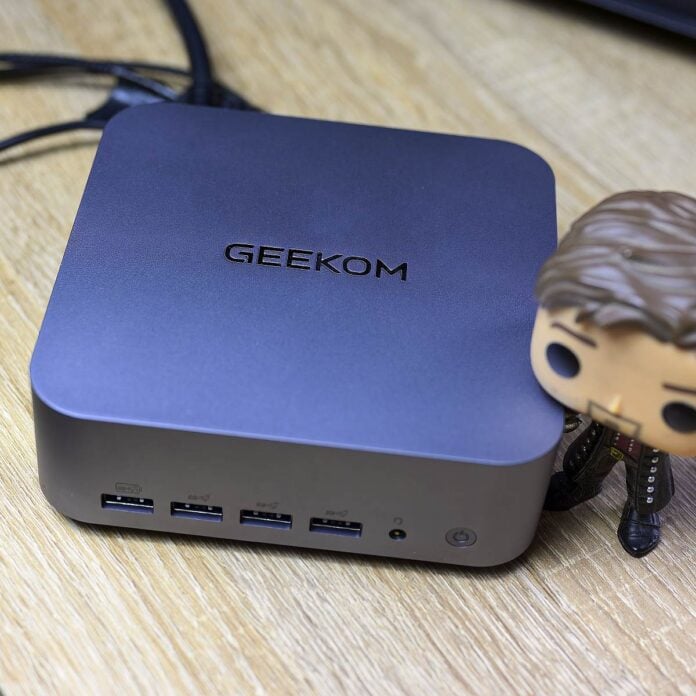Do you want a compact powerhouse PC that fits seamlessly into any setup yet delivers next-generation performance? Try the Geekom GT1 Mega mini PC – a high-end AI machine designed to impress professionals and enthusiasts alike with its compact form, Intel 14th Gen Core Ultra CPUs, numerous ports, and a sharp, modern design.
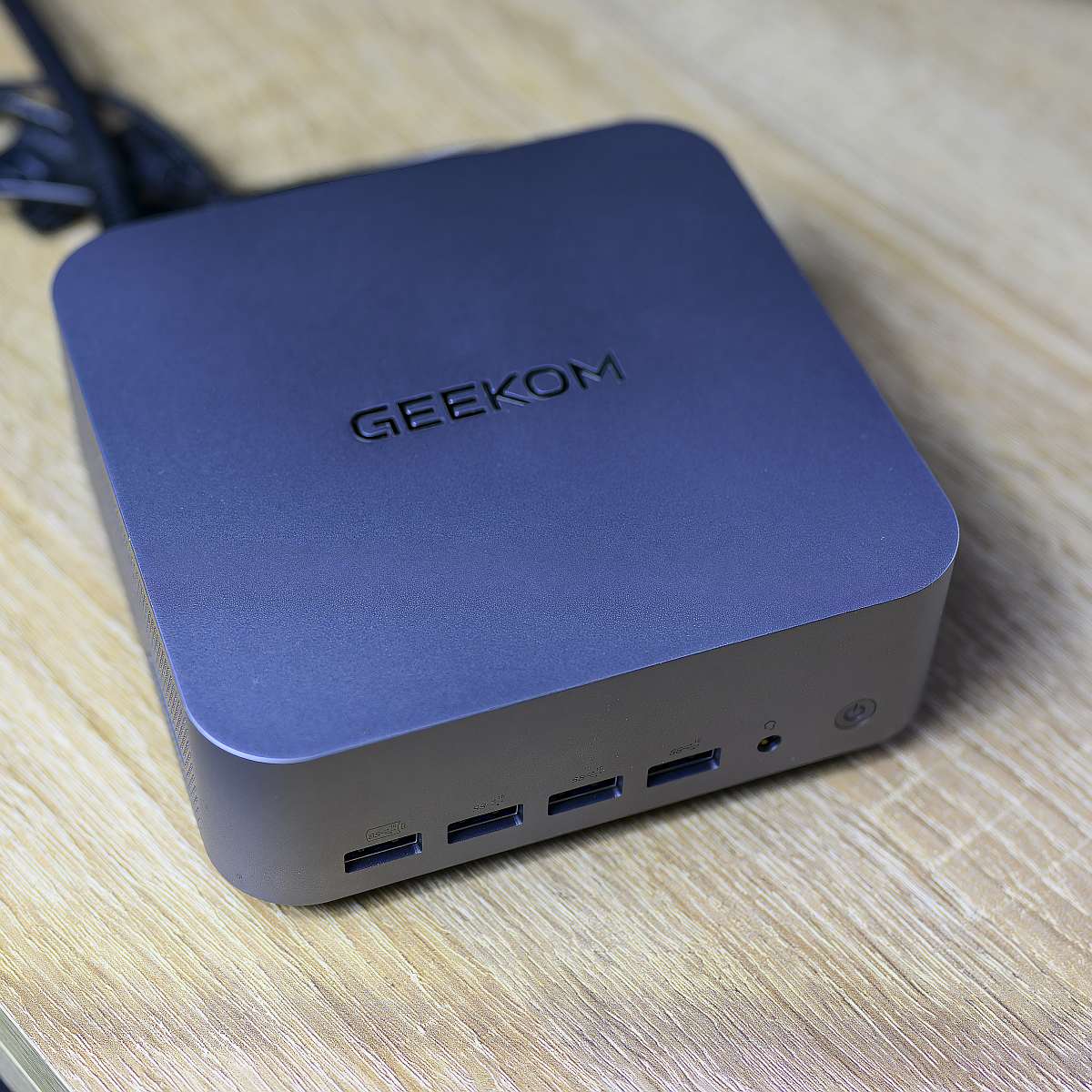

Geekom GT1 Mega
£989 / $989
Pros
- Very good Intel Core Ultra performance
- Tidy, fit-anywhere design
- Loads of ports: dual 2.5GbE LAN, dual USB4, SD card reader, 2xHDMI 2.0
- Up to 64GB RAM and 2TB NVMe SSD support
- WiFi 7 & Bluetooth 5.4, latest AI acceleration
Cons
- Runs warm and rather loud under sustained loads
- No official support for 4 TB drives
- Premium price
- Lack of USB Type-C port at the front
Club386 may earn an affiliate commission when you purchase products through links on our site.
How we test and review products.
Suppose you’re a powerhouse professional seeking serious performance, a creator working with heavy-duty apps, or simply someone who refuses to settle for a clunky setup. In that case, I believe the Geekom GT1 Mega is impressive. This mighty little machine is compact in size but ferocious in its capabilities – you’ll be surprised at the power packed into its sleek frame.
Specifications
Under the hood, it doesn’t mess around. Armed with Intel’s mobile 14th Gen CPU options – up to an i9 with 16 cores and 22 threads – it chews through workloads, creative projects, and multitasking without breaking a sweat. But brute force is only half the story. Geekom goes big on user experience, too, offering a balanced mix of cutting-edge connectivity and premium design that seamlessly integrates into any desk with absolute style.
Ports? Glad you asked. The GT1 Mega comes fully loaded: USB 4 and 3.2 Gen 2 for lightning-fast data transfers, an SD card reader for creators on the go, plus WiFi 7, Bluetooth 5.4, and two 2.5 GbE LAN ports that guarantee rock-solid networking whether you’re gaming, streaming, or working remotely.
You can choose from multiple configurations at varying price points. The top model, which I have for review, retails for £989 or $989 and features a Core Ultra 9 185H CPU with 16 cores and 22 threads, as well as Arc graphics with ray tracing and XeSS upscaling. Its default 45W can run all the way up to 115W if thermals allow. That comes paired with 32GB RAM and a 2TB SSD. Those who don’t require such power or storage can opt for a Core Ultra 5 125H variant (14 cores/18 threads), featuring 32GB RAM and a 1TB SSD setup, which reduces the price by a considerable £500/$500.
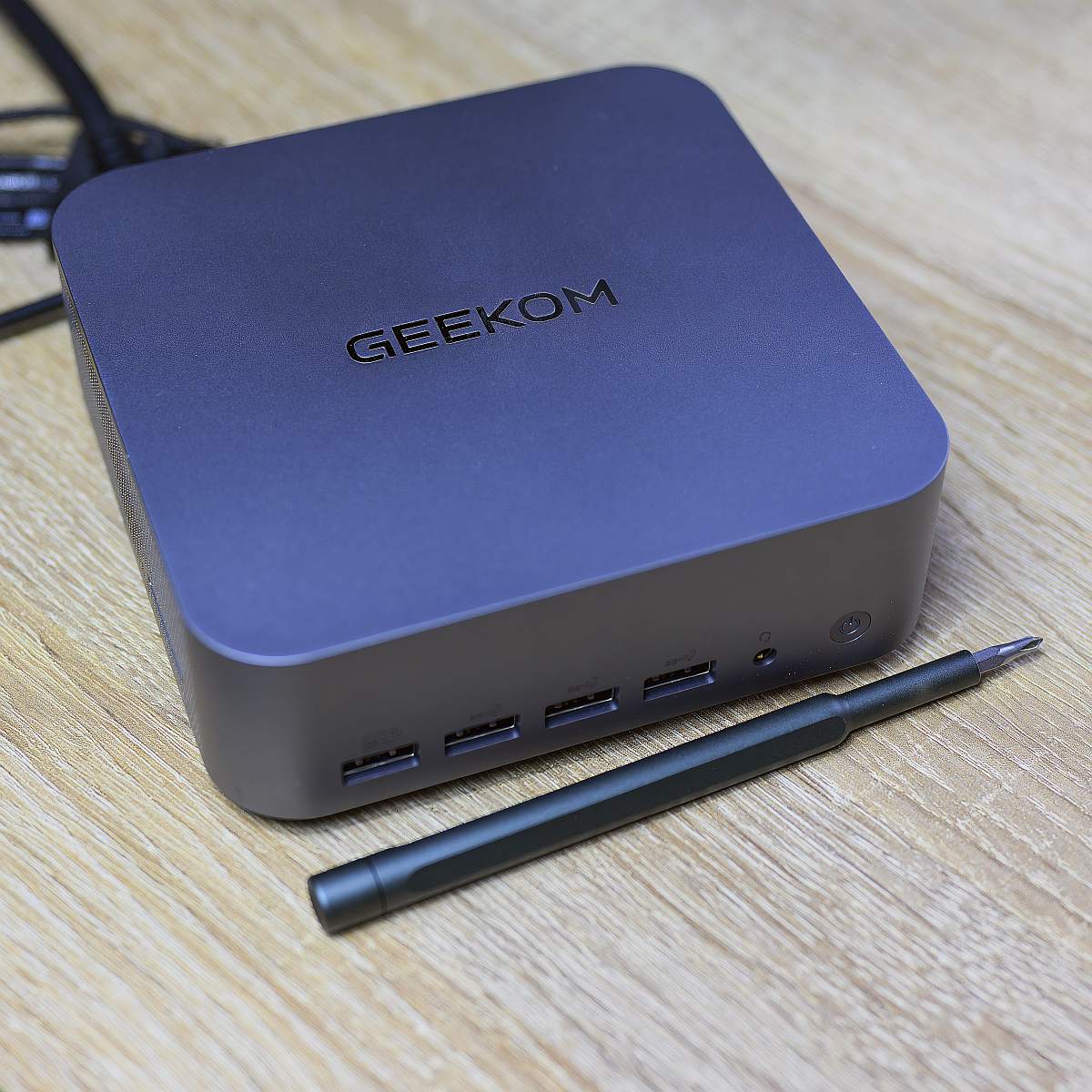
DDR5 memory is limited to a maximum of 64GB per unit, and more importantly, there are storage restrictions to be aware of. For reasons unknown, Geekom’s official documentation states you can employ up to 1TB in the M.2 2242 SATA slot, up to 2TB in the M.2 2280 NVMe PCIe Gen 4.0 x4 port, and up to a 2TB drive in the 2.5 SATA bay.
Here’s a breakdown of the key specs.
| Geekom GT1 Mega specs | |
|---|---|
| Dimensions | 135 × 132 × 44.35 mm |
| Weight | 680g |
| CPU | Up to Intel Core Ultra 9 185H (16C/22T, 5.1 GHz Turbo, 45W TDP); Also available with Core Ultra 5 125H |
| GPU | Intel Arc Graphics (up to 8 Xe-cores, 2.35 GHz) |
| Memory | Dual-channel DDR5, up to 64GB (2x SODIMM, 5600MHz) |
| Storage | 1 × M.2 2280 NVMe PCIe 4.0 ×4 SSD, 512GB or 1TB onboard, expandable up to 2 TB 1 × M.2 2242 SATA, 2242 slot, expandable up to 1 TB |
| Operating System | Windows 11 Pro |
| Bluetooth® | Bluetooth® v5.2 |
| Ethernet | Intel® 10/100/1000/2500 Mbps RJ45 x 2 |
| Wireless LAN | Intel M.2 Wi-Fi 7 |
| Kensington Lock | Yes |
| Adapter | 19V power adapter, with geo-specific AC cord (IEC C5) |
| I/O Ports | 1 × USB 3.2 Gen 2 Type-A (back panel) |
| 1 × USB 2.0 Type-A (back panel) | |
| 4 × USB 3.2 Gen 2 Type-A (front panel, one port supports Always On) | |
| 2 × USB4 (back panel, one port supports Type-C Power on) | |
| 1 × 3.5 mm stereo headset jack (front panel) | |
| 2 × RJ45 (back panel), 2.5 Gbps | |
| 2 × HDMI (back panel) | |
| 1 × DC in (back panel) | |
| 1 × Power Button | |
| 1 × Kensington Lock | |
| 1 × SD Card 4.0 × USB 3.2 Gen 2 ports |
These robust specifications of Geekom GT1 Mega combine the flagship Meteor Lake CPU power, the latest Arc graphics, and ample RAM and fast storage, all in a compact footprint that’s barely larger than a paperback.
Design & Build Quality
Unboxing
The Geekom GT1 Mega arrives in a sleek, well-padded black box. It makes a very positive first impression. A full configuration label on the underside makes it easy to verify the specs of the following components: CPU, RAM, and SSD, right out of the box.
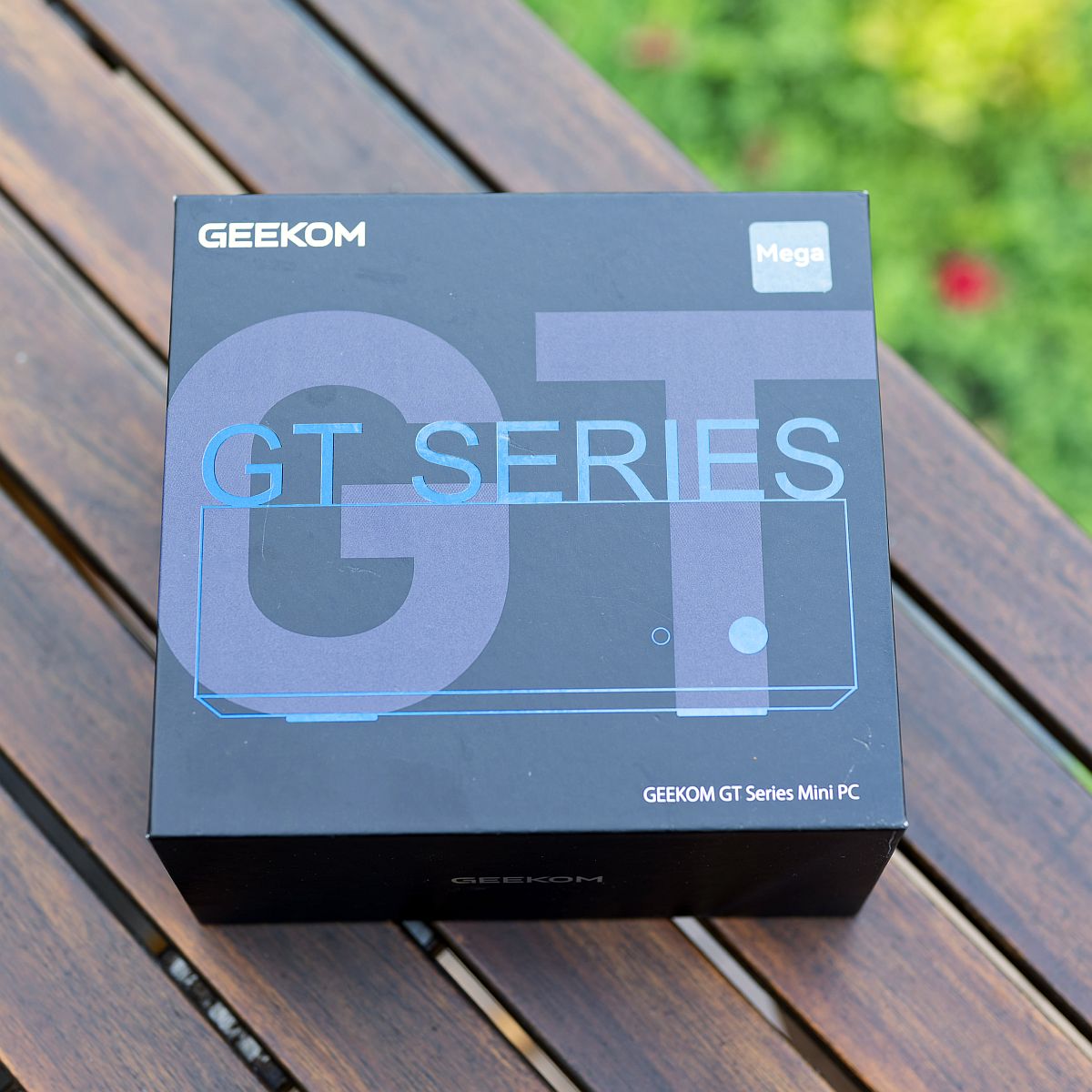
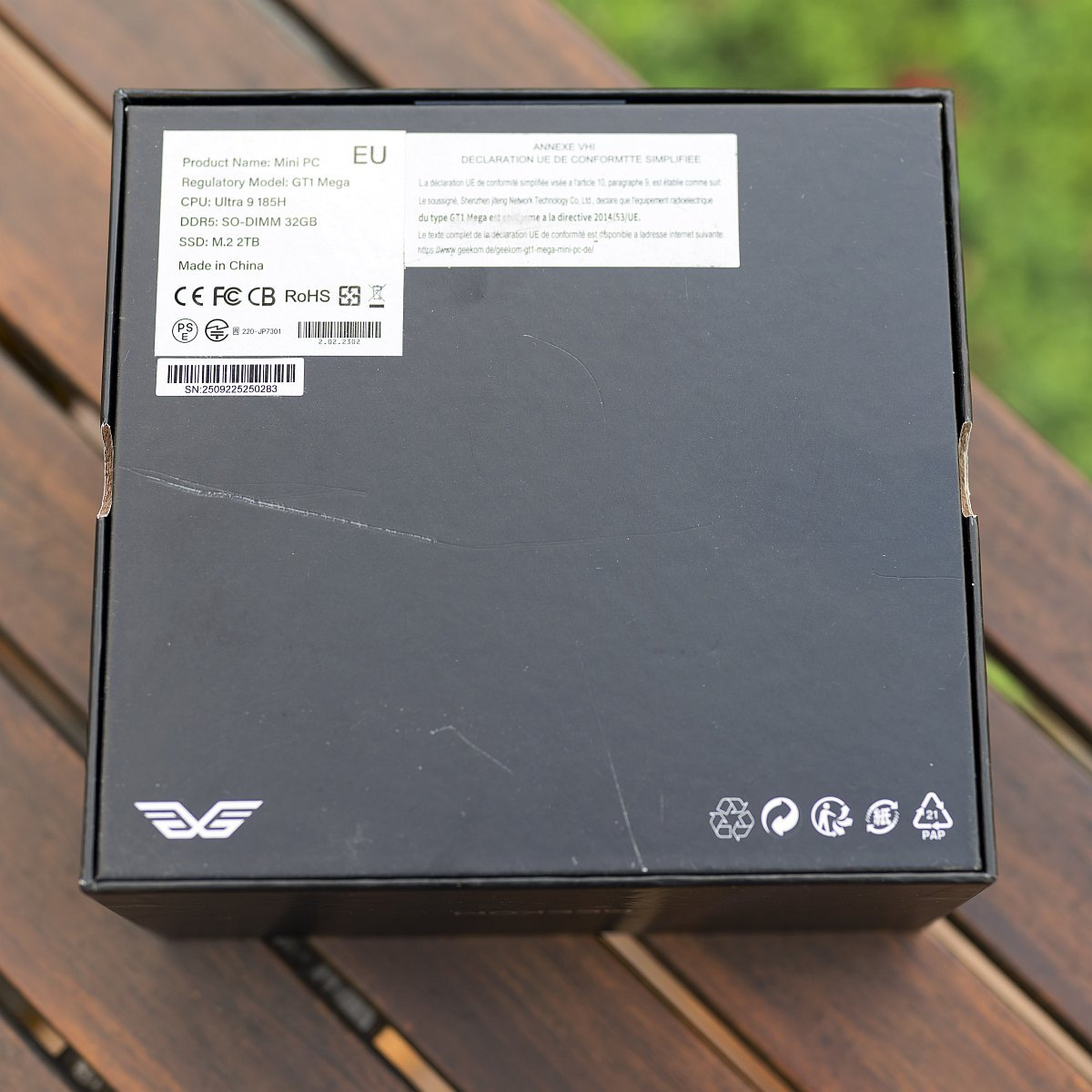
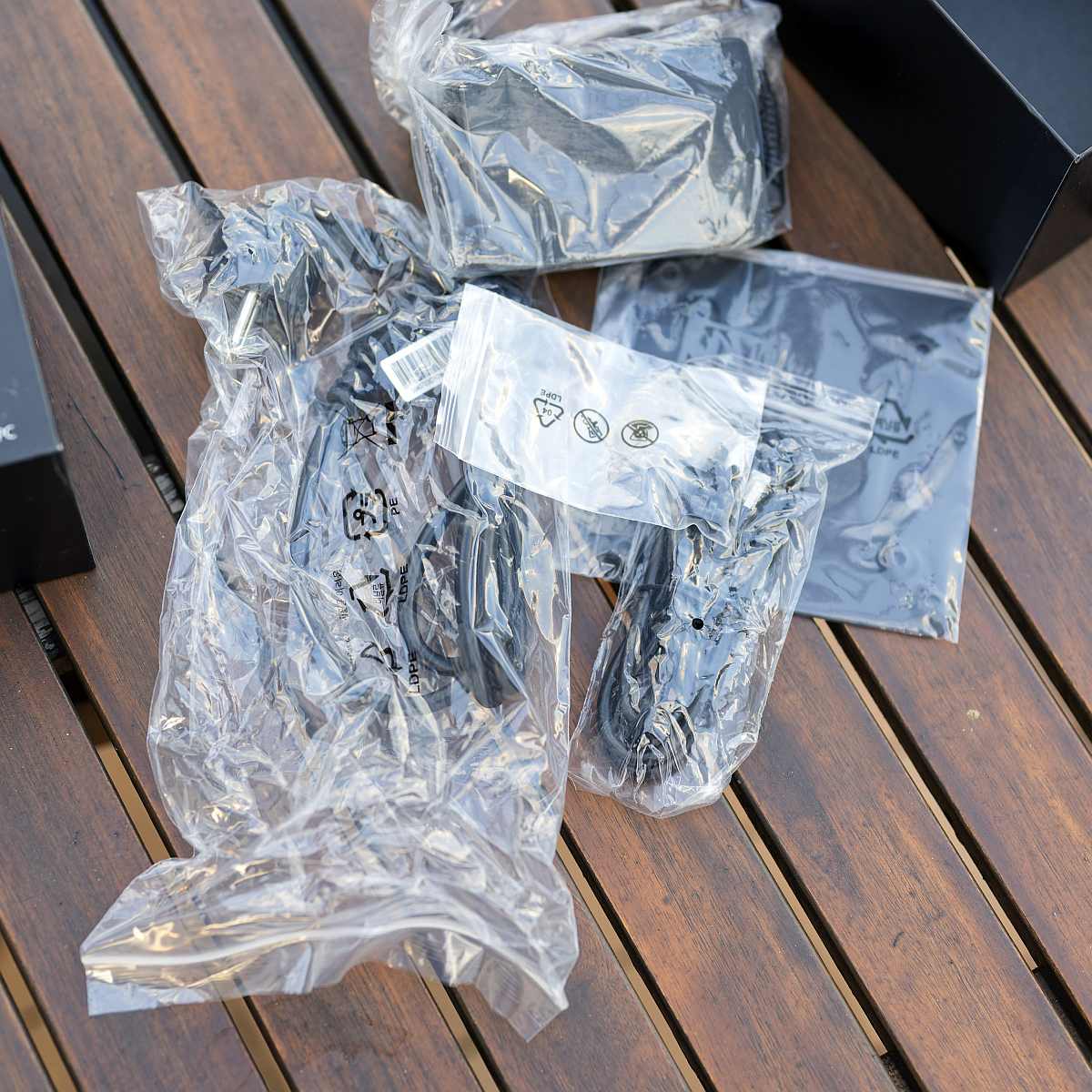
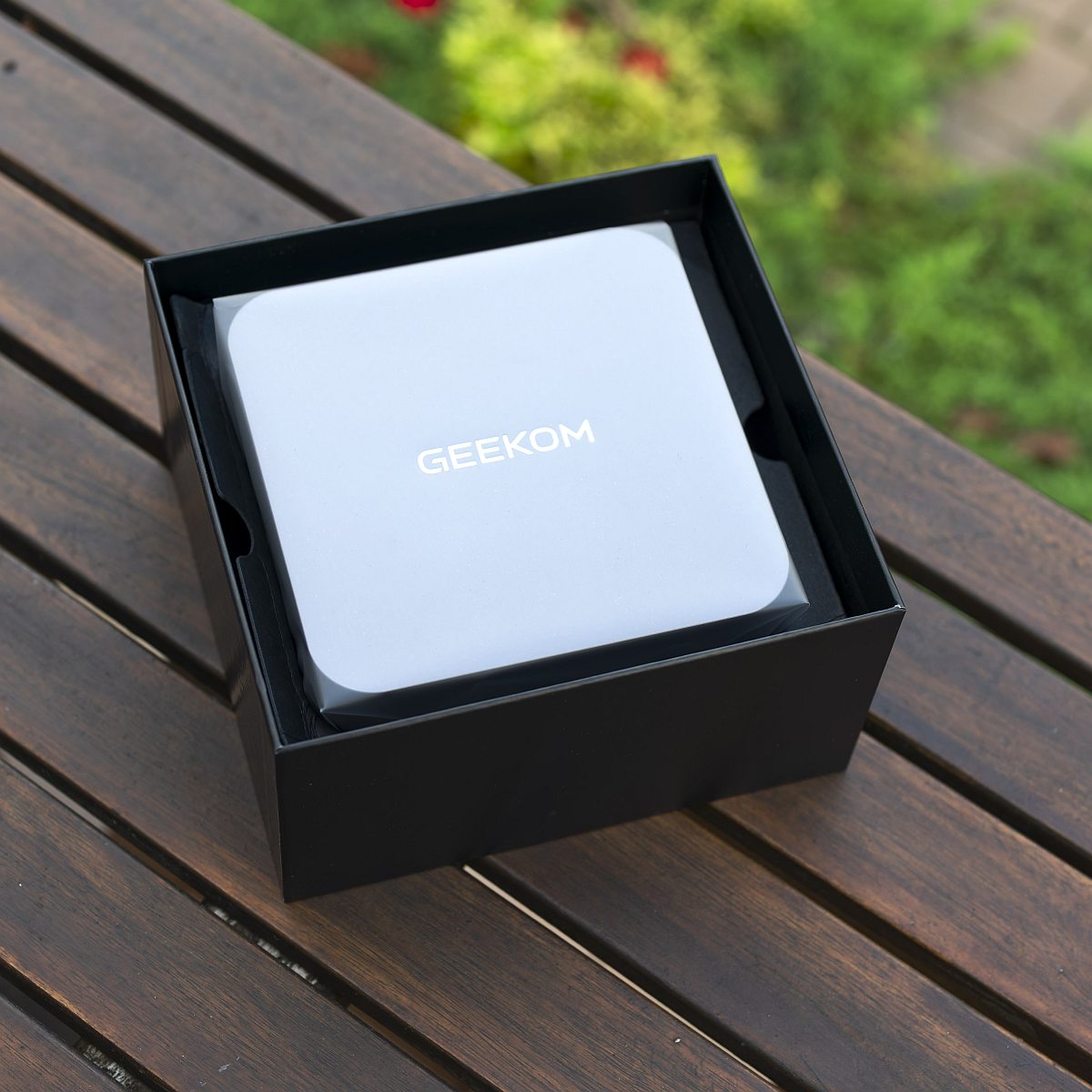
In the box you can find:
• Mega GT1 Mini PC
• VESA Mount (with screws)
• Power Adapter (120 W)
• HDMI Cable
• User Guide
• Thank You Card
First impressions
Out of the packaging, the compact chassis stands out as it’s designed for versatility. I find it’s equally at home tucked behind a monitor, via a VESA mount, or showcased on a minimalist desk. The Geekom GT1 Mega is all about compactness and quality, although it’s slightly wider/deeper, but marginally thinner (135 x 132 x 44.35 mm) than the Geekom IT12 2025 (117 x 112 x 49.2 mm).
The anodised metal chassis, finished in a subtle matte grey, feels both tough and elegant, with reinforced corners and clean seams that resist fingerprints. The subtle Geekom logo and minimalist design ensure it fits well into both professional and home environments, while the smart ventilation design maintains efficient airflow without compromising aesthetics.
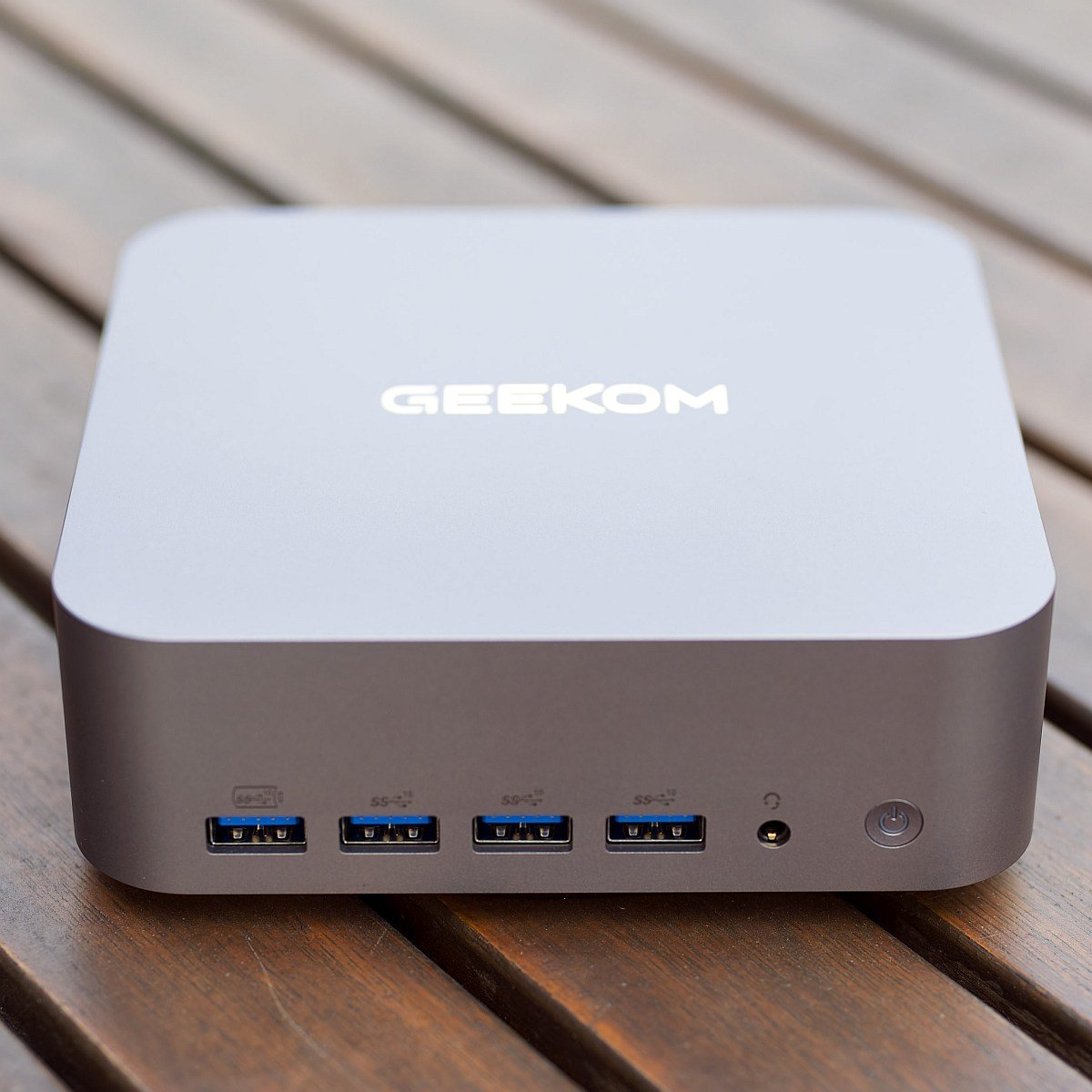
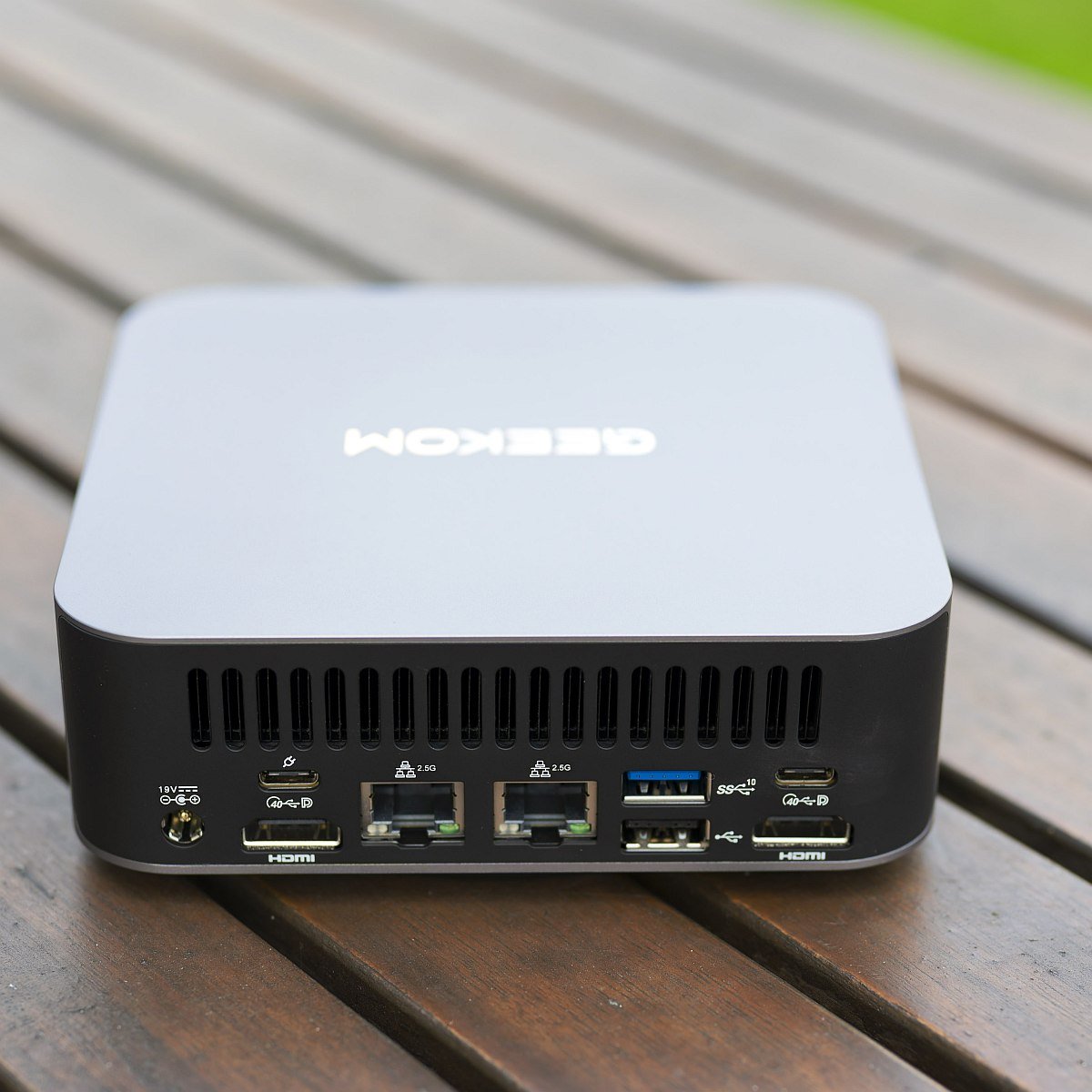
The generous port arrangement is carefully laid out for accessibility, featuring two USB4 ports and two LAN ports at the back, along with multiple high-speed USB ports and additionally an HDMI 2.0 port. The front hosts four Type-A USB 3.2 ports. One feature that would be beneficial to have there is a USB Type-C port, and I’m surprised by its absence on this side.
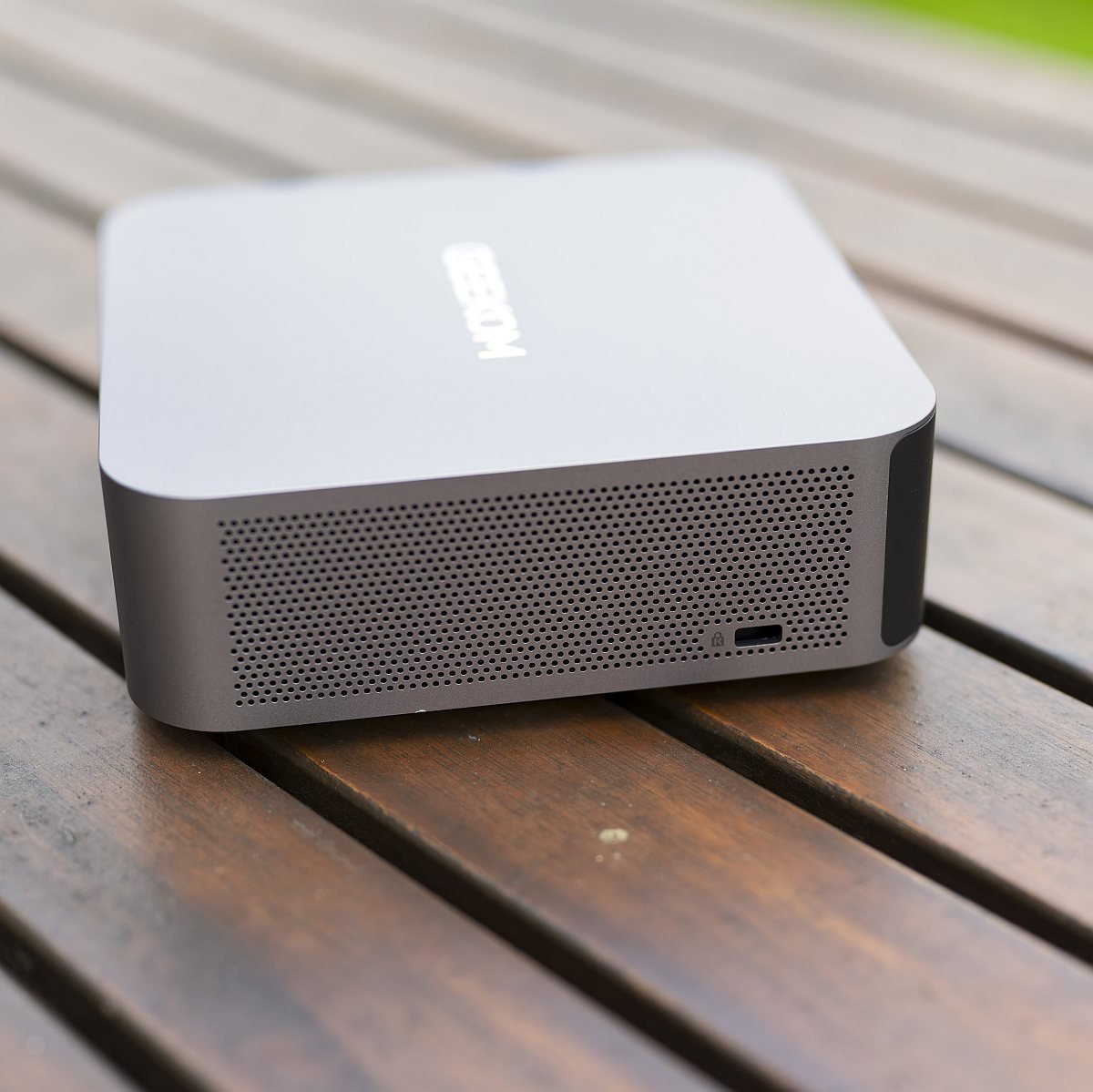
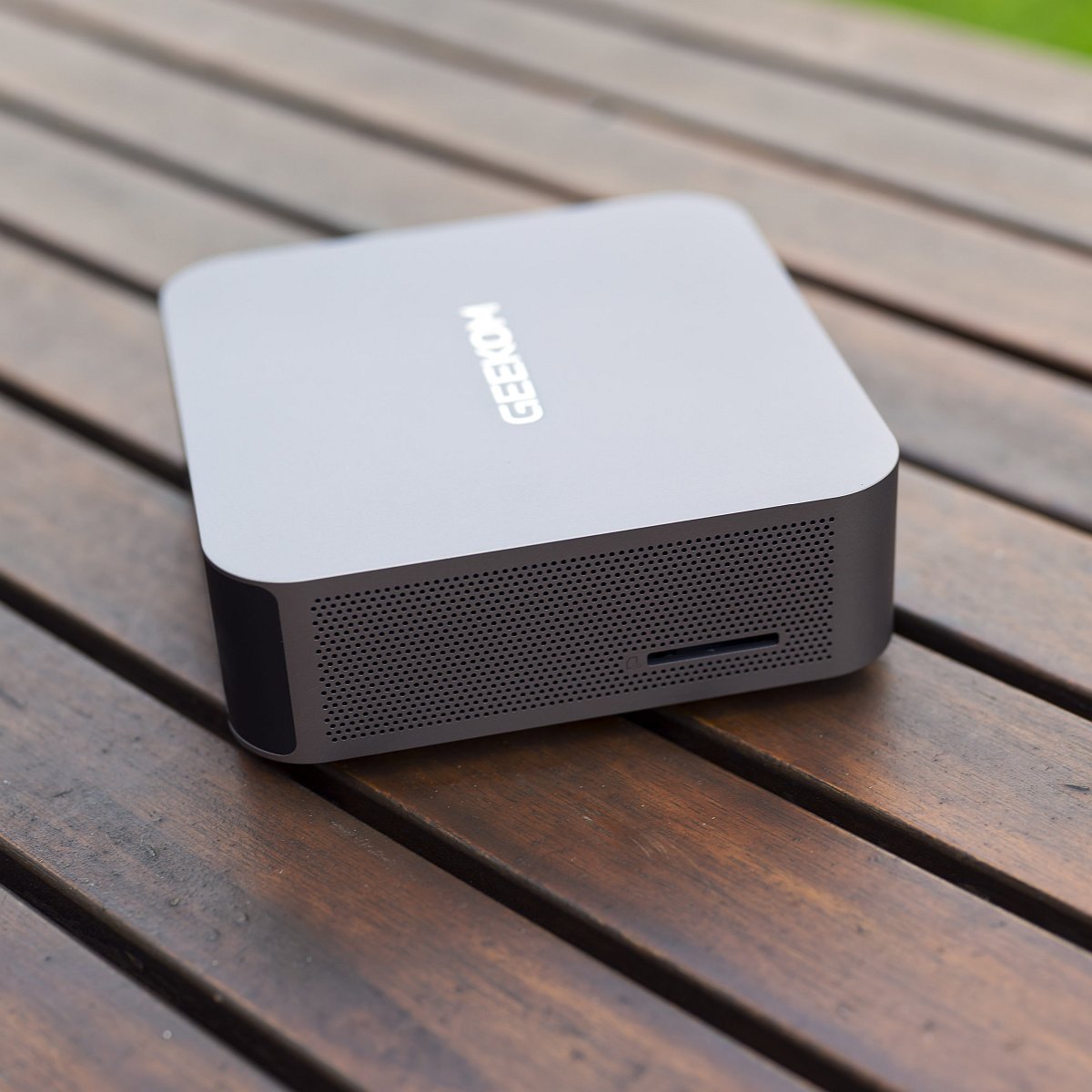
A full-size SD card reader on the left side of the chassis is a welcome addition for photographers and content creators, while HDMI + USB 4.0 outputs make multi-monitor setups straightforward. There’s also a Kensington Lock over on the right side.
Internals
After removing the top cover, you can see the cooling system. At the bottom of the chassis, you can find information about the model, the required power, and the manufacturer. Slipping the bottom cover off requires undoing four screws, which allows you to see the 2 TB Lexar NQ7A1 SSD (LNQ7A1X002T), which is specced with performance up to 6,000 MB/s read and 5,000 MB/s write that’s typical for a PCIe Gen 4 x4 NVMe SSD. There’s additionally a space for an optional M.2 2230 drive.
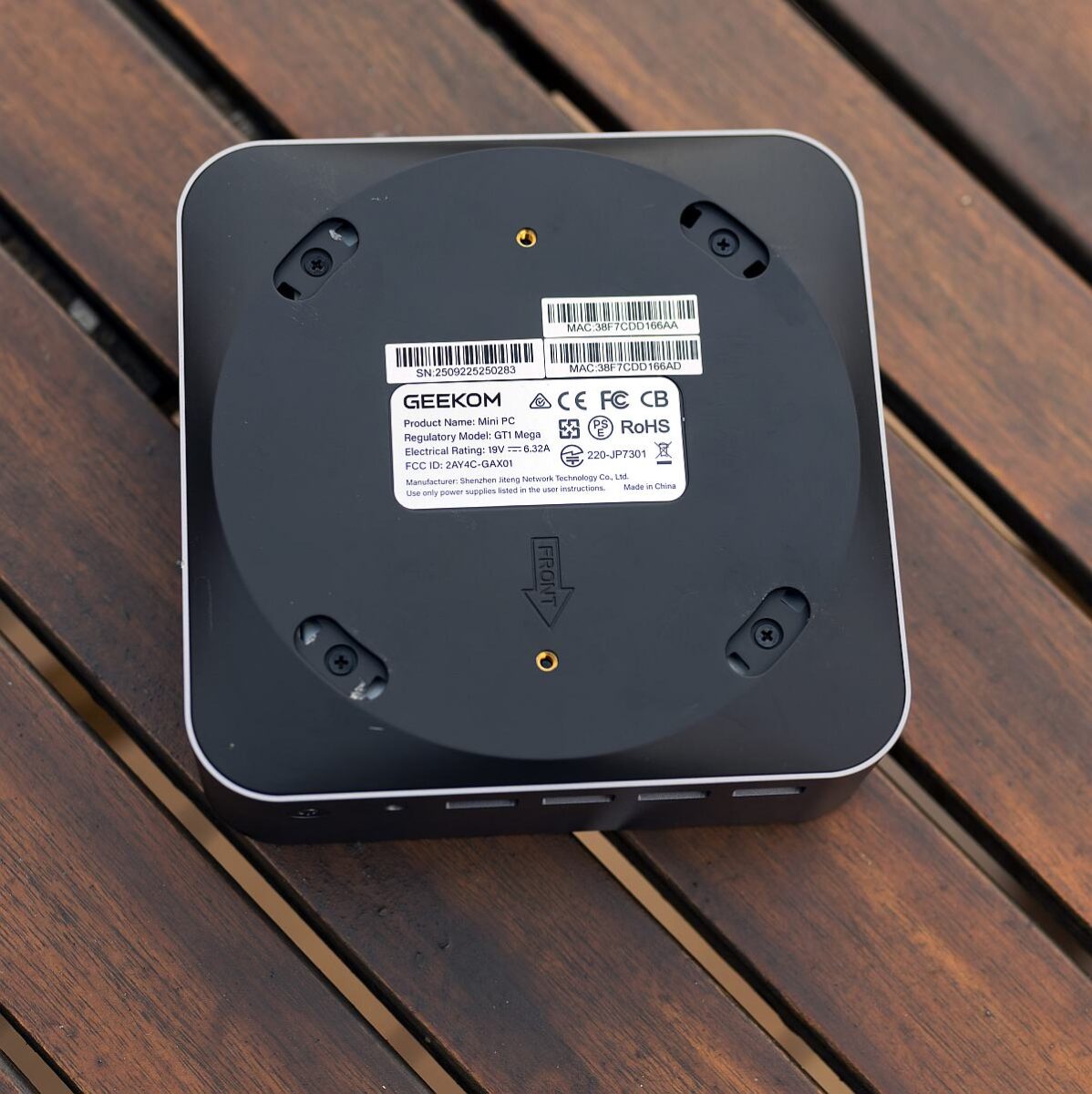
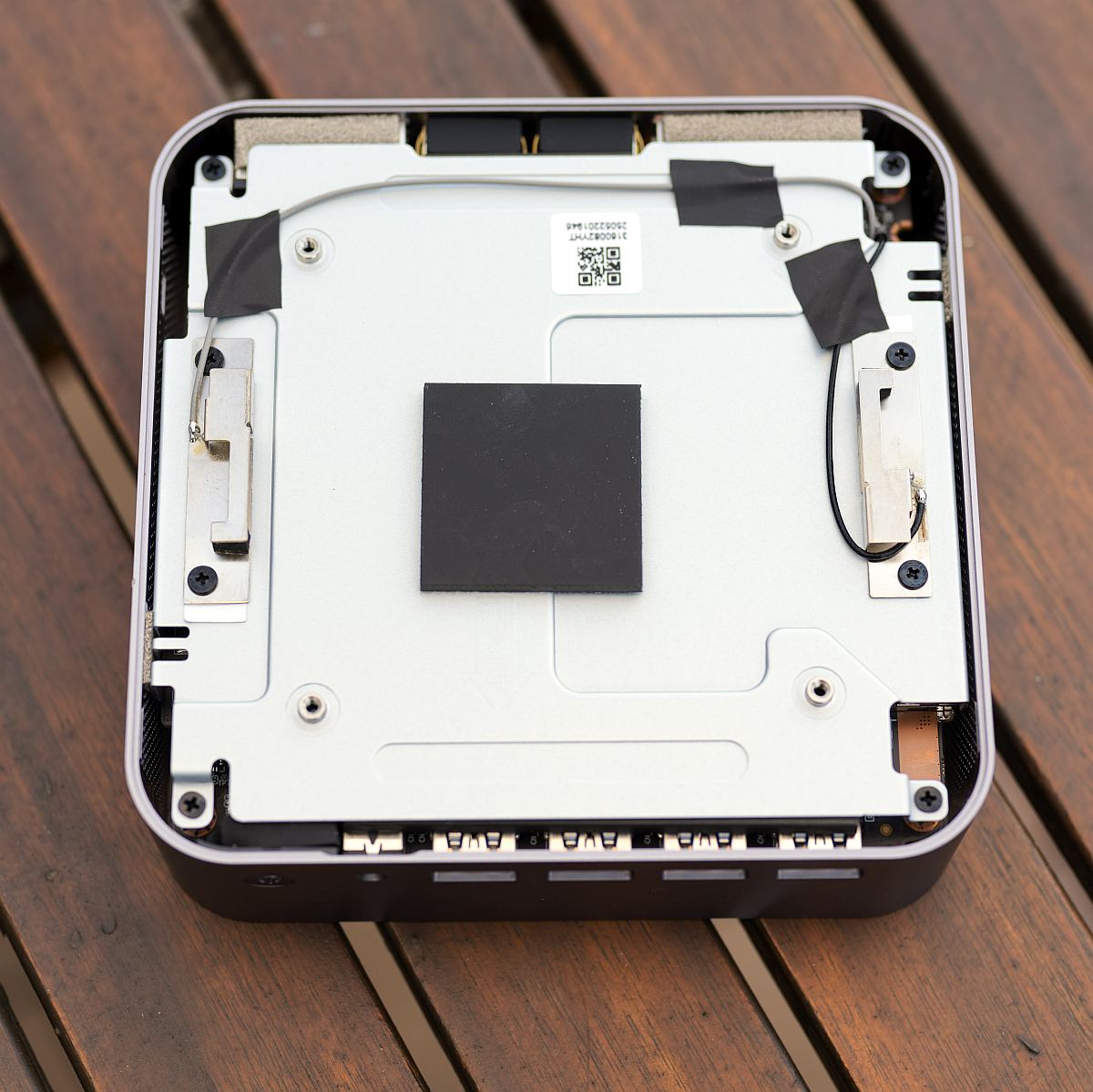
The two DDR5 modules, from Netac (WPBS56D508SWB-16G), operate at 1.2V with a frequency of 5,600MHz and CL46 timings. There’s a cooling and a thermal pad for the M.2 2280 drive attached to the bottom cover.
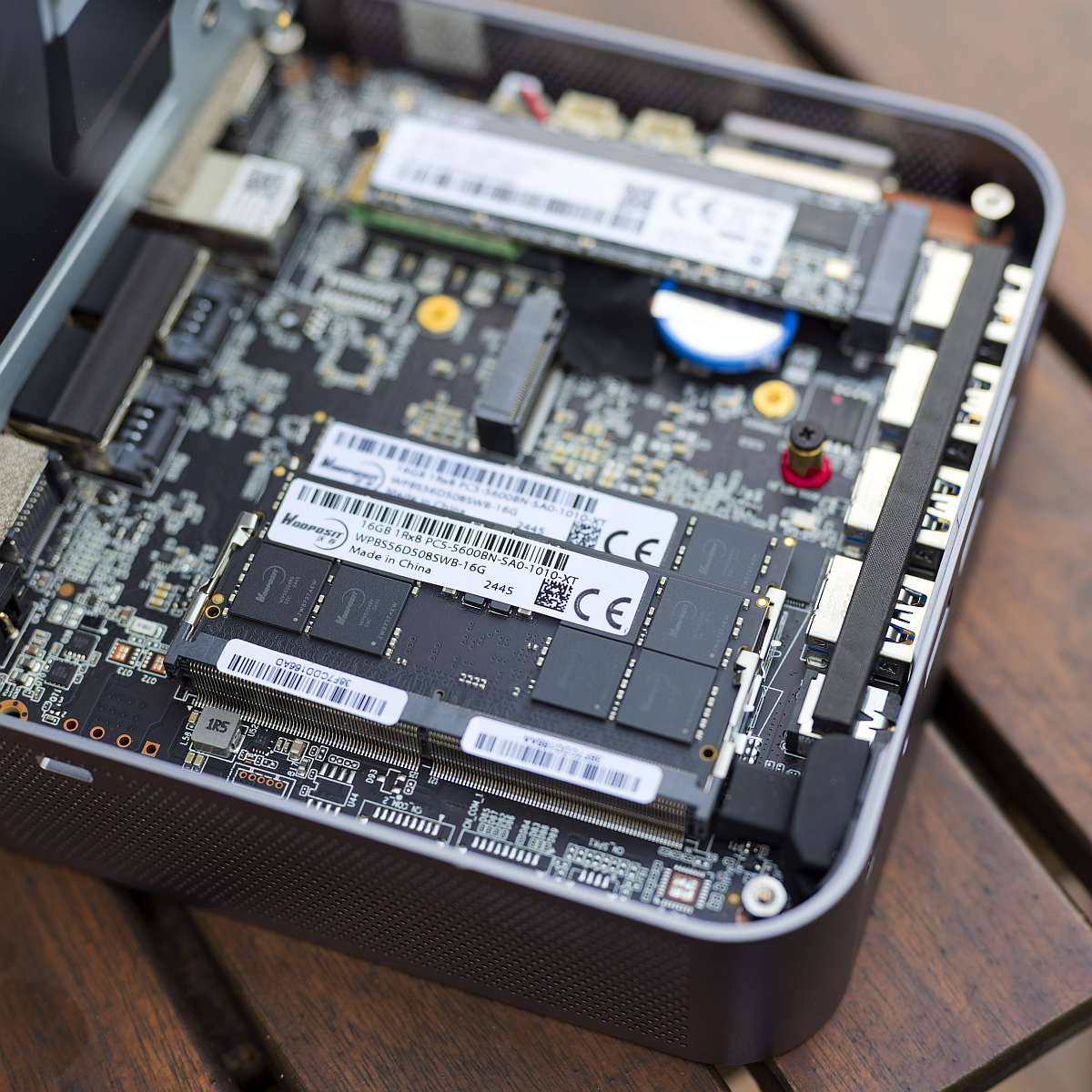
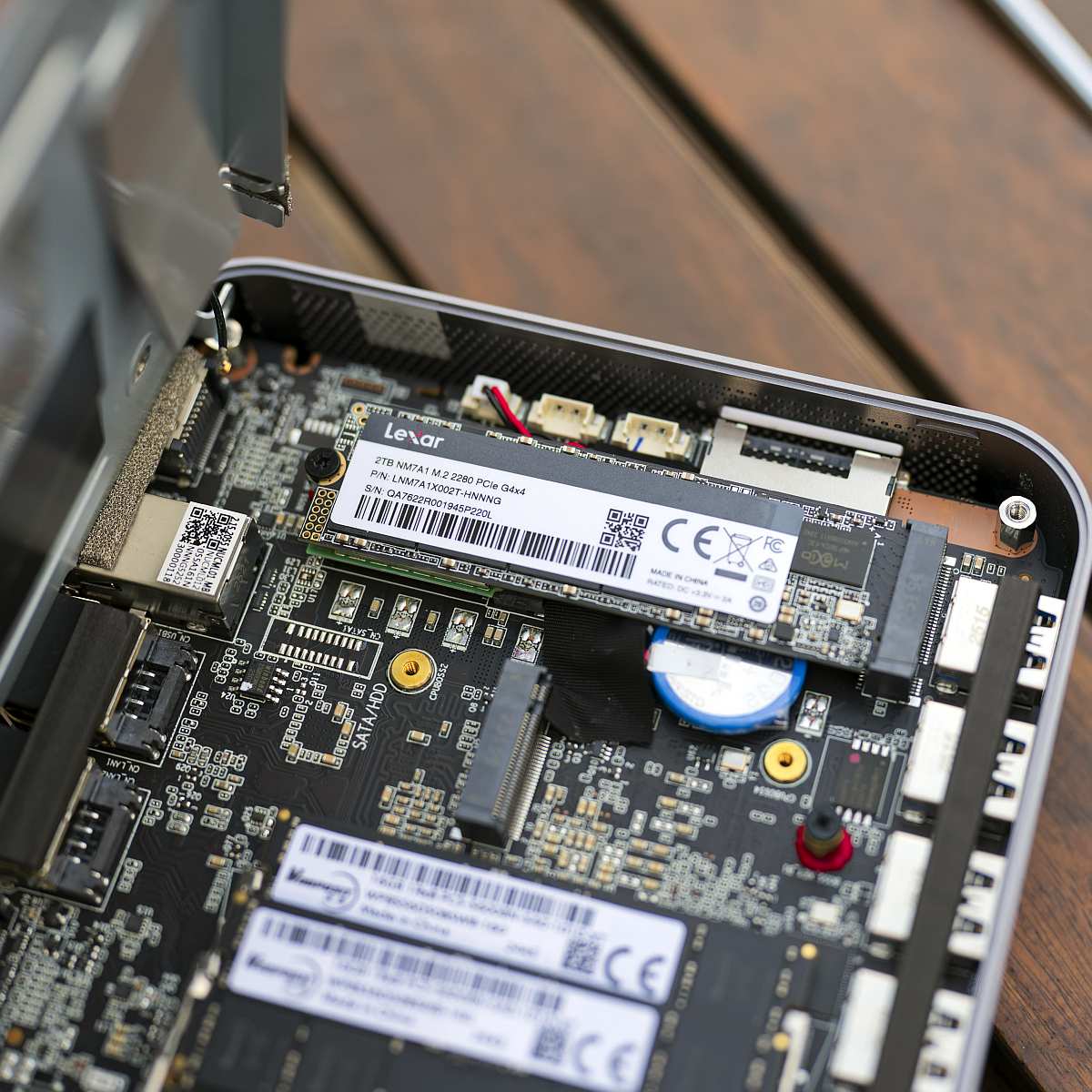
One important note to keep in mind is that reinstalling the wireless card when reassembling can be a bit tricky. The Wi-Fi antennas are short, and if you stretch the cover too much, they will disconnect from the card, thus making the signal almost non-existent. After that, it’s very challenging to reattach it, as they’re hidden under the M.2 drive and are very small. While swapping RAM or SSDs is straightforward, the short antenna cables mean the service plate can’t be fully removed, making the process more awkward than it should be.
Performance
As I mentioned, the Geekom GT1 Mega features a 16-core, 22-thread Intel Core i9 185H CPU with integrated Intel Arc graphics. At first boot, you’ll need to complete the Windows 11 installation by setting the language, keyboard layout, and other necessary settings, but that’s always the norm. Then, it’s always worth checking CPU-Z to see if everything is showing what it should:
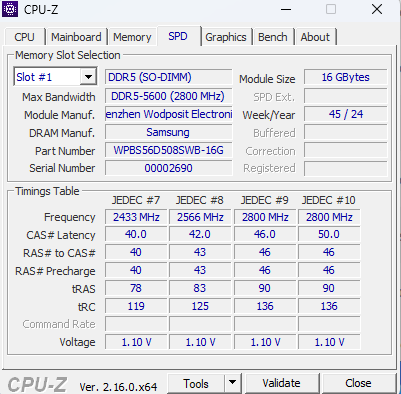
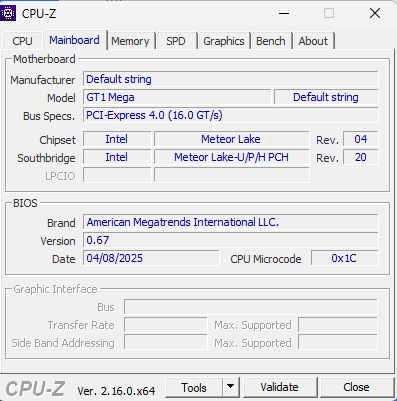
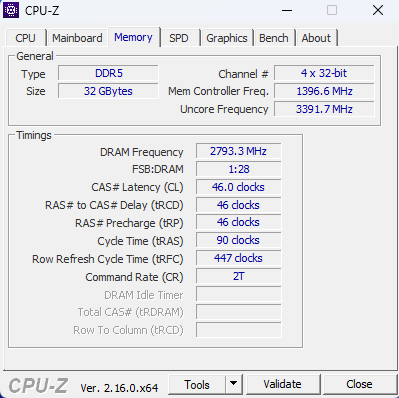
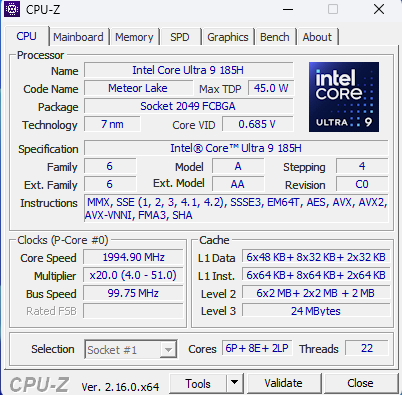
The DDR5 RAM provided here works at 5600 MHz, with CL46/45/45 timings. Happy days.
Benchmarks
The Geekom GT1 Mega delivers very good figures across a range of benchmarks, showcasing its capability as a powerful mini PC:
| Benchmark | Geekom GT1 Mega (Core Ultra 9 185H) | Geekom IT12 2025 (Core i7-1280P) | GPD WinMax 2 (Ryzen 7 8840U) |
|---|---|---|---|
| CPU-Z | 702.3 single-thread 7,622.9 multi-thread | 611.4 single-thread 5,174.3 multi-thread | 639.2 single-thread 4,936.9 multi-thread |
| Cinebench 2024 | 109 single-core 932 multi-core | 93 single-core 558 multi-core | 98 single-core 708 multi-core |
| Cinebench R23 | 1,739 single-core 18,524 multi-core | 1,504 single-core 8,516 multi-core | 1,525 single-core 10,446 multi-core |
| AIDA64 | 80,782 MB/s read 74,139MB/s write 73,306MB/s copy 140.5ns latency | 44,634MB/s read 44,988MB/s write 45,622MB/s copy 86.9ns latency | 50,447MB/s read 92,880MB/s write 69,498MB/s copy 123.8ns latency |
| AS SSD | 5,239.39MB/s seq. read 5,169.44MB/s seq. write | 4,070.53MB/s seq. read 3,887.47MB/s seq. write | 4,019.02MB/s seq. read 3,511.04MB/s seq. write |
| PCMark 10 | 7,269 | 5,182 | 5,784 |
| 3DMark Fire Strike | 7,097 | 4,785 | 7,234 |
| 3DMark Night Raid | 31,531 | 16,234 | 26,657 |
| 3DMark Steel Nomad | 3,025 | 172 | 2,592 |
| 3DMark Time Spy | 3,859 | 1,781 | 3,056 |
Although Geekom doesn’t list the make and model of the storage drive in any of its marketing materials, we can see in various software utilities that our drive is a 2 TB Lexar NQ7A1 SSD identified as model number LNQ7A1X002T.
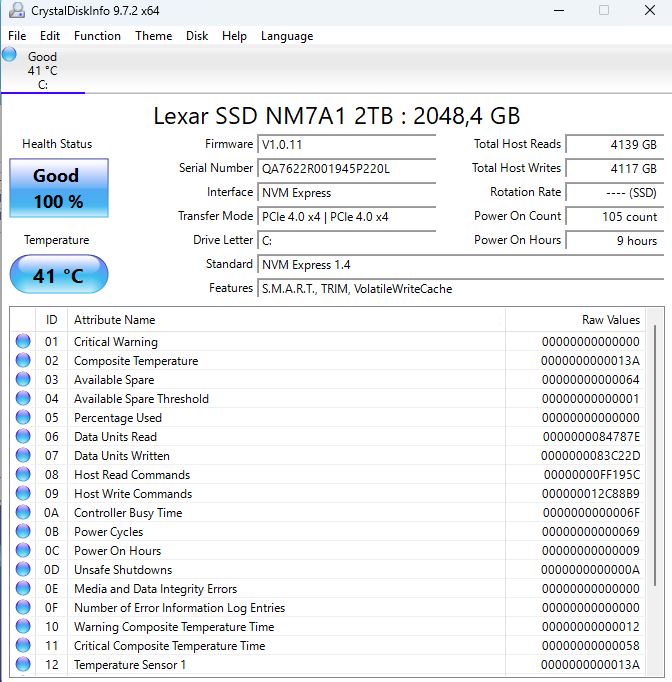
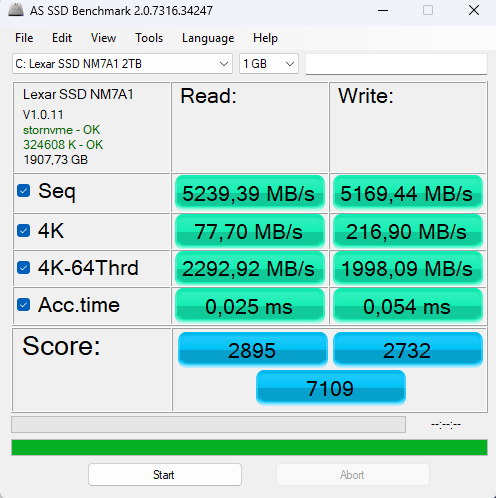
All is well here, too, with strong sequential read and write speeds for a mid-tier Gen4 M.2.
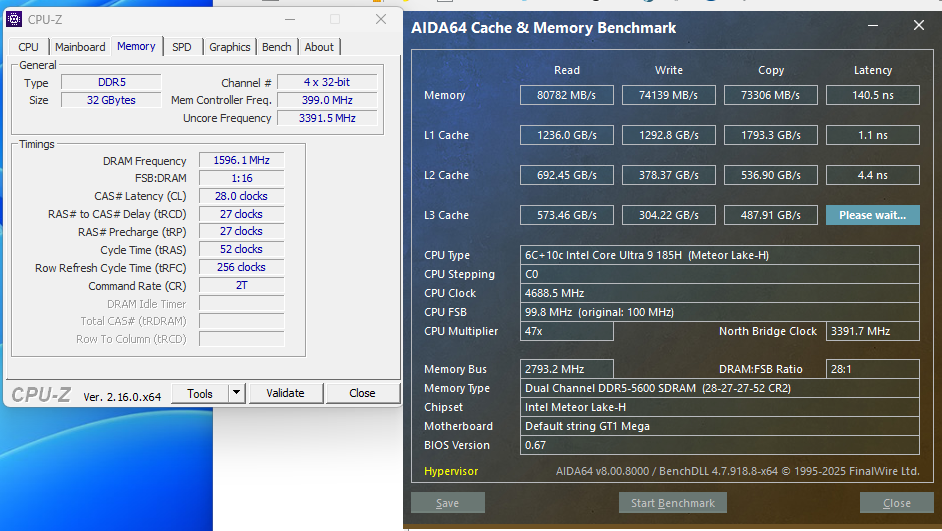
AIDA64 memory results align with what you would expect for the 5600 MHz DDR4 RAM.
Gaming
Geekom GT1 Mega isn’t built primarily as a gaming powerhouse, but the baked-in Intel Arc graphics can deliver decent performance for casual gaming. For newer AAA titles, you’ll need to dial down settings and expect framerates of around 30fps or less, making the system best suited for lightweight titles rather than modern heavy hitters. You’ll need to temper expectations, so think more ‘casual stroll’ than ‘full throttle.’
| Geekom GT1 Mega (Core Ultra 9 185H) | Game Framerate (Min/Avg) |
| Forza Horizon 5 FHD, Medium, 8x MSAA, DX12 | 35/46 fps |
| Fortnite FHD, Medium, DX12 | 55/83 fps |
| Shadow of the Tomb Raider FHD, High | 31/46 fps |
| Marvel’s Spider-Man Remastered FHD, Low, FSR 2.1 (Quality) | 35/49 fps |
| Street Fighter 6 FHD, Low, internal resolution:4 | 58/62 fps |
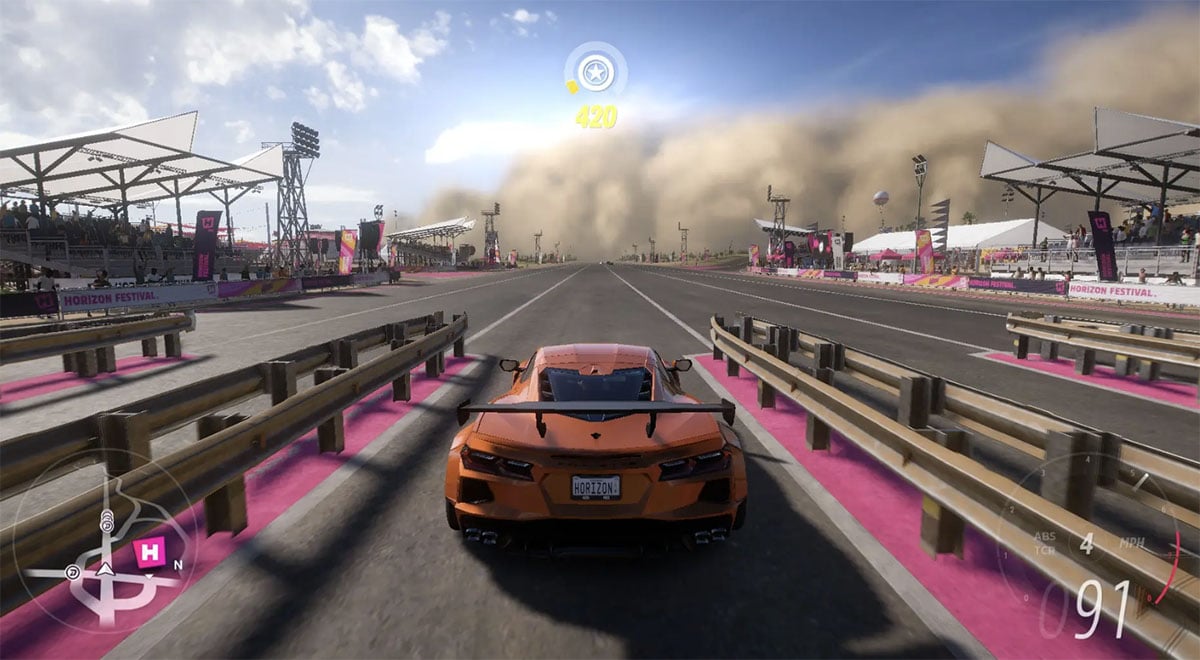
Forza Horizon 5 is very demanding on the system, although it is possible to maintain playable frame rates at FHD. To achieve a framerate locked closer to 60fps, you’d need to lower the details from medium.

As a competitive shooter, Fortnite needs to keep a rather high pace. Here, the experience is quite optimal and comfortable, because there are no drops below 30fps, and the average is around 80fps.

For Shadow of the Tomb Raider, it is possible to use the FHD resolution (not 720p like in Geekom IT12 2025) and the gameplay is quite smooth, as there is no dip below 30fps.

Zipping through New York City skylines and beating up baddies in Marvel’s Spider-Man Remastered, on the other hand, is rather enjoyable, with no dips below 30fps and just enough performance to keep those Spidey senses tingling in FHD resolution.

Street Fighter 6 offers the closest approximation to a stable 60fps, providing silky-smooth gameplay. However, the resolution has to be set to 1080p with low settings, and the internal resolution to 4. You can concentrate on your combos rather than stutters that would otherwise lose you the fight.
Day-to-Day
Geekom GT1 Mega is engineered for daily multitasking, creativity, and productivity. Whether using 20 Chrome tabs, editing media, crunching spreadsheets, or running AI inference tasks, I find it hums along without lag. The rich I/O makes streaming, multi-monitor setups, and storage expansion easy, while its Wi-Fi 7 and dual 2.5Gb LAN bring future-proof networking.
Do you love editing photos, making videos, or dabbling in design? Programs like Photoshop and Premiere Pro run smoothly, in my experience, so you can focus on being creative instead of waiting for things to load. The typically quiet operation during light tasks and quick SSD speeds set it apart from cheaper mini PCs or laptops.
Vitals
BIOS
With a basic BIOS, there’s not much to swap or change. However, everything is pretty much in order.
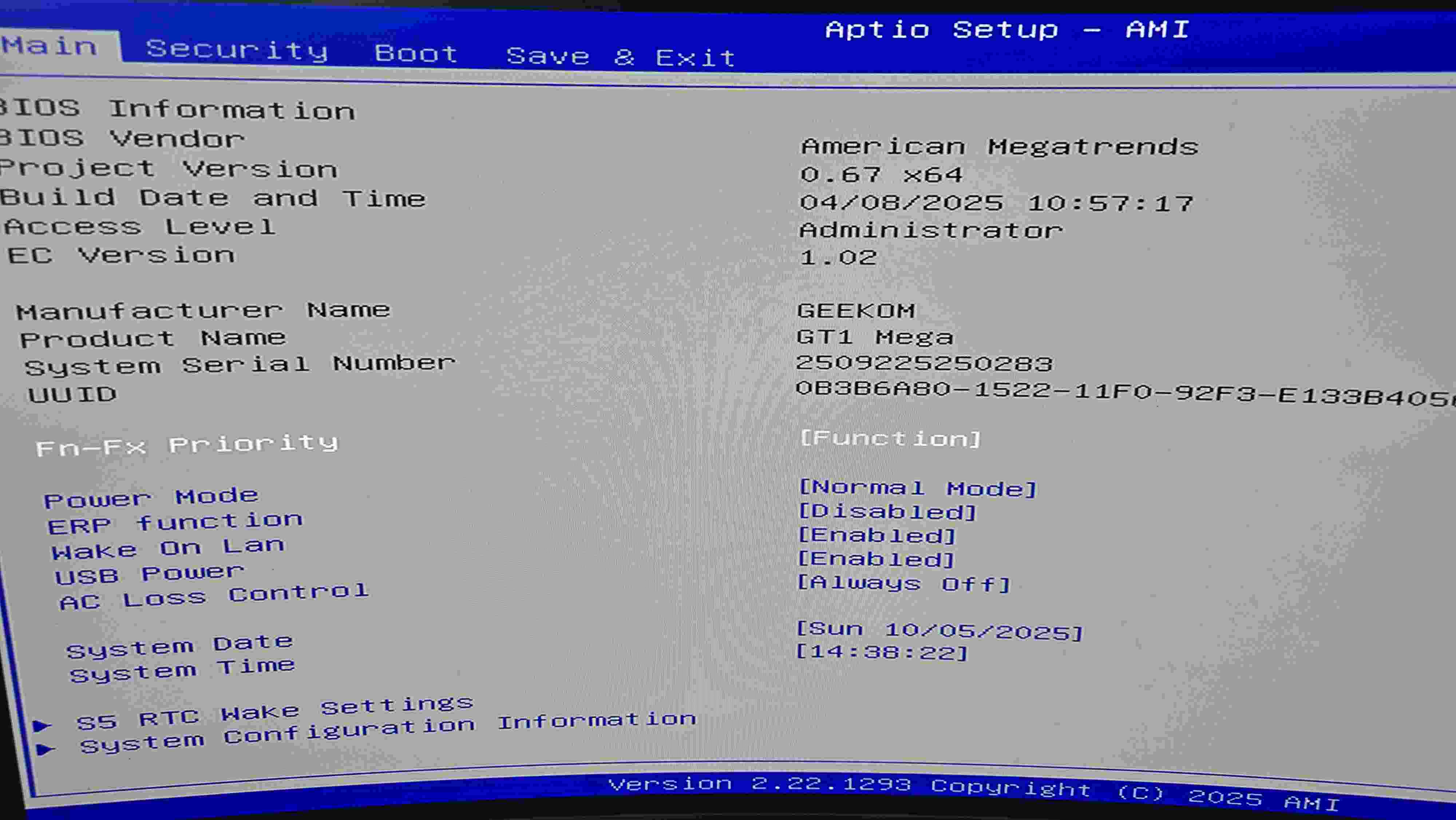
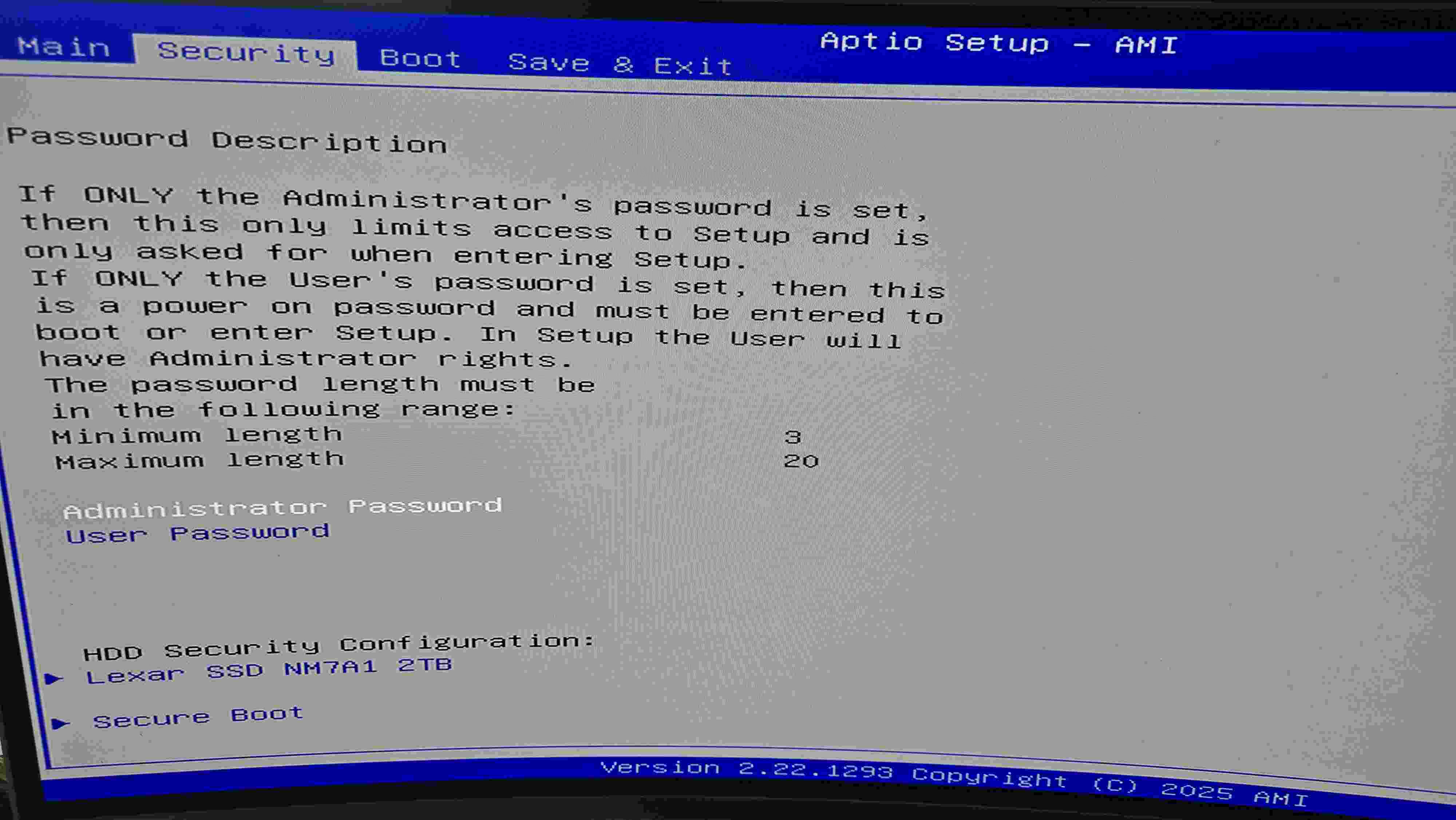
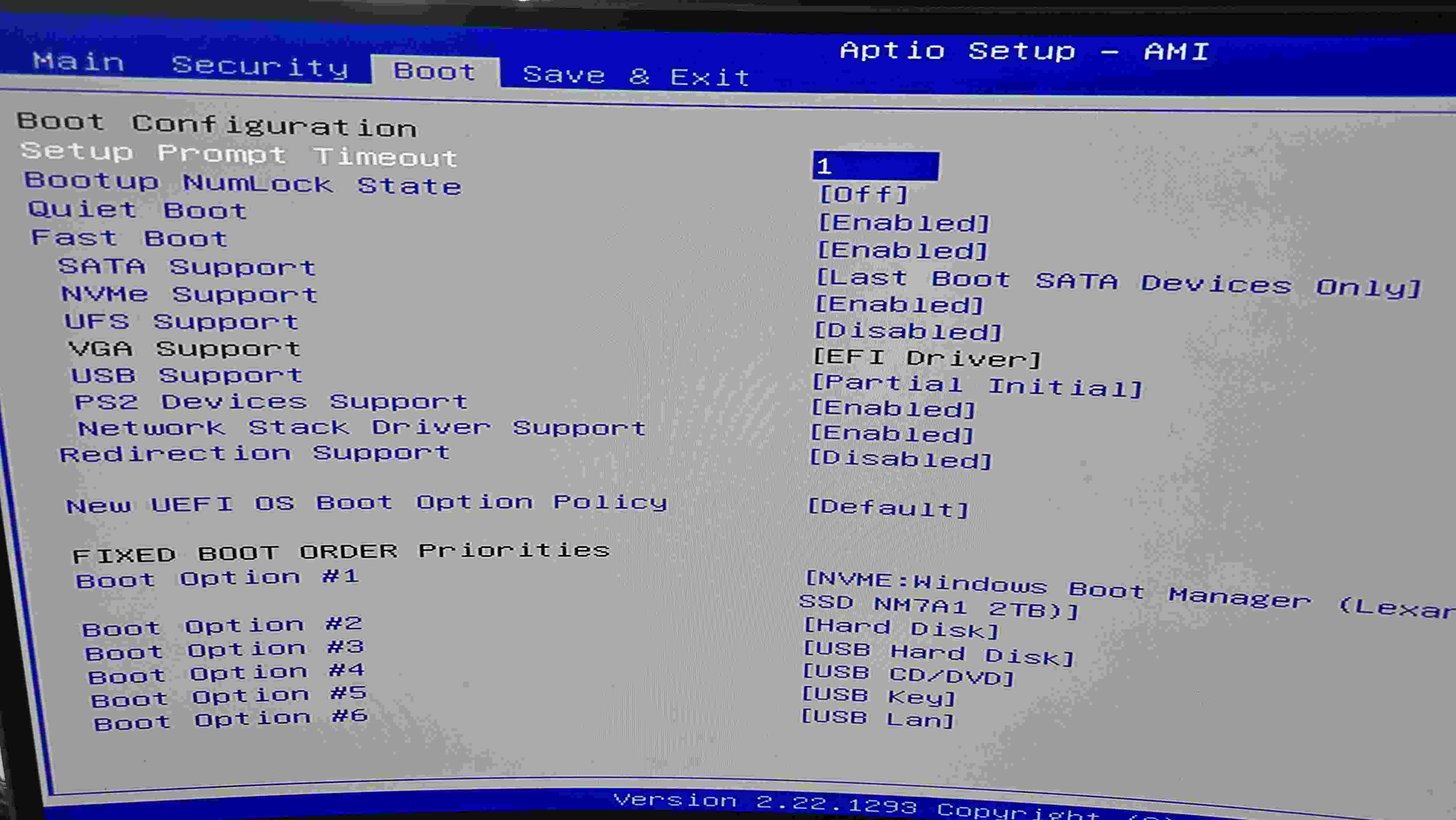
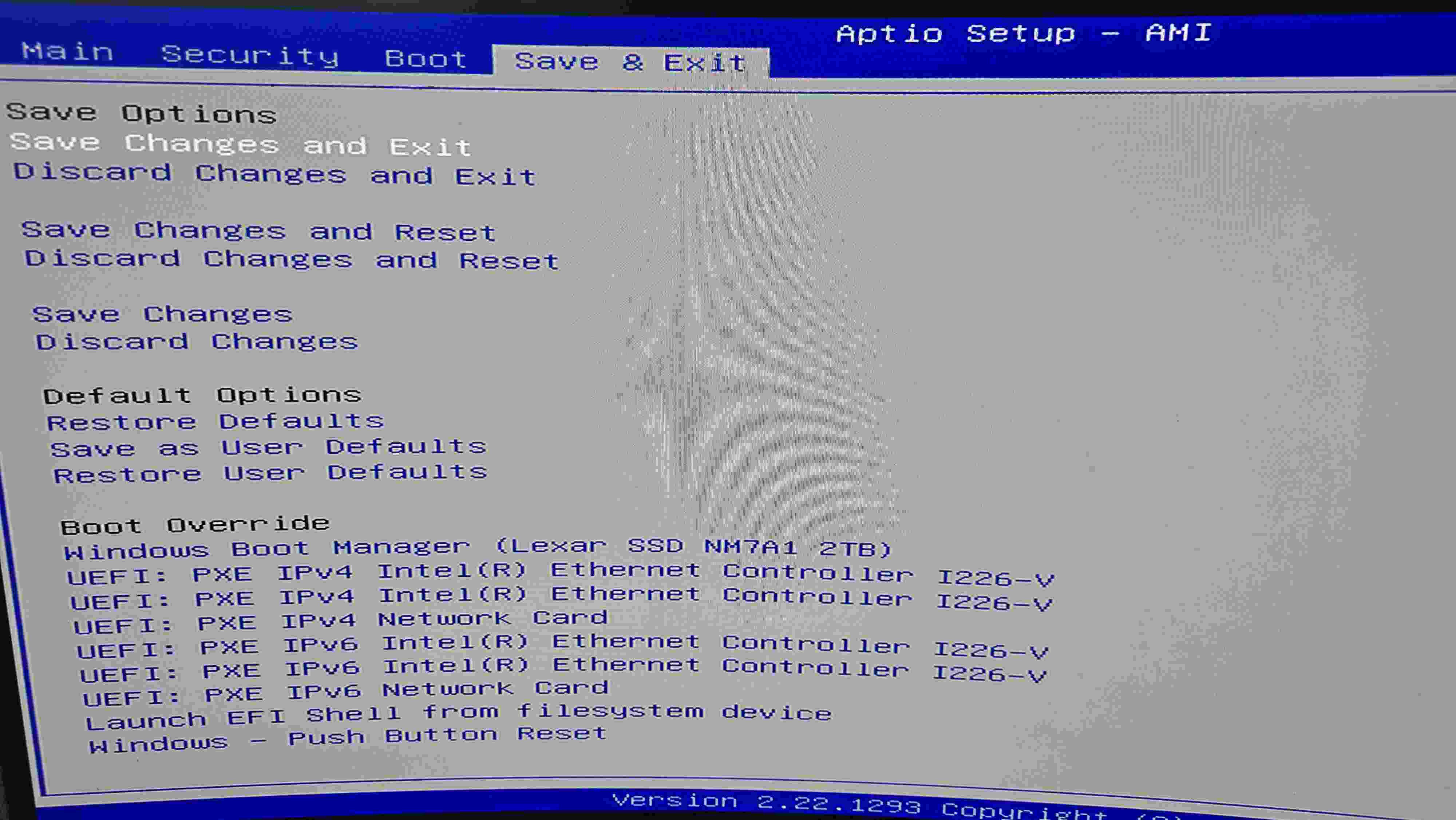
Power Efficiency
Let’s talk about energy. Geekom GT1 Mega sips power instead of guzzling it.
Even when you’re working hard, it uses way less electricity than a regular desktop, which is around 100 watts or more for many of them. That means lower bills and less heat, which is most welcome during this latest heatwave; the room won’t turn into a sauna because of the PC, even if you leave it running all day.
And, of course, using less power is better for the environment, so you can feel a little greener every time you turn it on.
Ideal for anyone who wants a powerful computer without feeling guilty about energy waste or sweating over summer power bills.
Despite its powerful specs, the Geekom GT1 Mega prioritises efficiency. Here’s what I measured in various scenarios.
- Idle: 5–7W
- Video playback (8K): 23–36W
- Gaming (Fire Strike): 54–60W
- Cinebench R23 multi-core (peak): 95–98W (short load)
- Sustained heavy load: 63–66W
For ordinary home, office, or creative use, most operations sip fewer than 30W. It consumes a fraction of the energy that full-sized desktops do, making it eco-friendly and suitable for small rooms. Only the most demanding workloads push the unit past 60W, which is rare in real-world usage.
Noise
The Geekom GT1 Mega balances compact size and strong performance, but this comes with moderate fan noise under sustained load. Again, I measured the following:
- Idle/quiet office tasks: 31-33dBA, barely audible because I have a 30dBA reference for background noise, roughly equivalent to the sound of a quiet library.
- Moderate multitasking, media or light gaming: 36-42dBA, noticeable but manageable, as it’s similar to a quiet office
- Prolonged full-load benchmarks, rendering or heavy gaming: Brief spikes up to 50dBA, with “toasty” chassis surface
So, summing it up, in idle mode, it is very quiet. Still, if you push it harder with heavy multitasking, video editing, or gaming, the fan ramps up to approximately 36-42 dBA, which is similar to the sound of a conversation. As mentioned above, peak loads will generate noticeable fan noise; prolonged use of Cinebench or gaming may reach a level of 50 dBA, which can be bothersome for those not wearing headphones.
Thermals stay in the safe zone thanks to the upgraded cooler, though the top cover and vent area can get warm, as I’ll illustrate below.
Temperature
Temperatures under load typically stay in the 70-80°C range for the CPU, which is safe and normal for this class of device. Under a heavy load, it can reach as high as 90°C. Below is the HWMonitor, showing temperatures of up to 86°C during a Cinebench 2024 run.
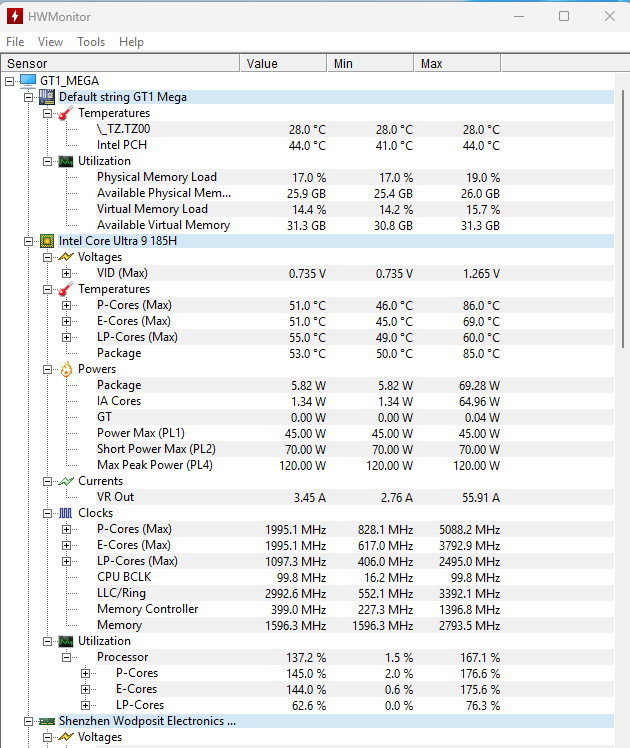
Chassis thermals under full load are highlighted in the FLIR pictures.
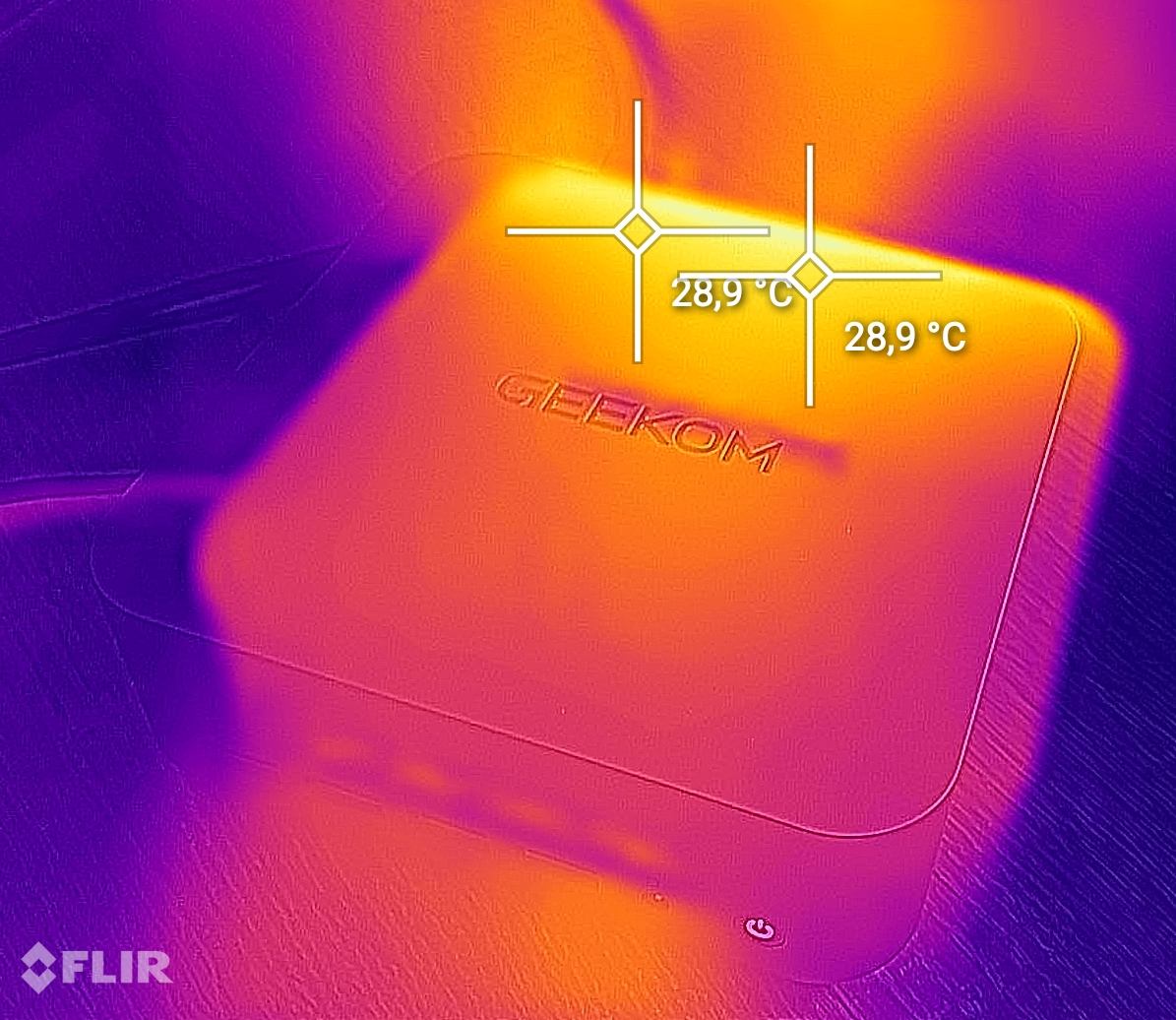
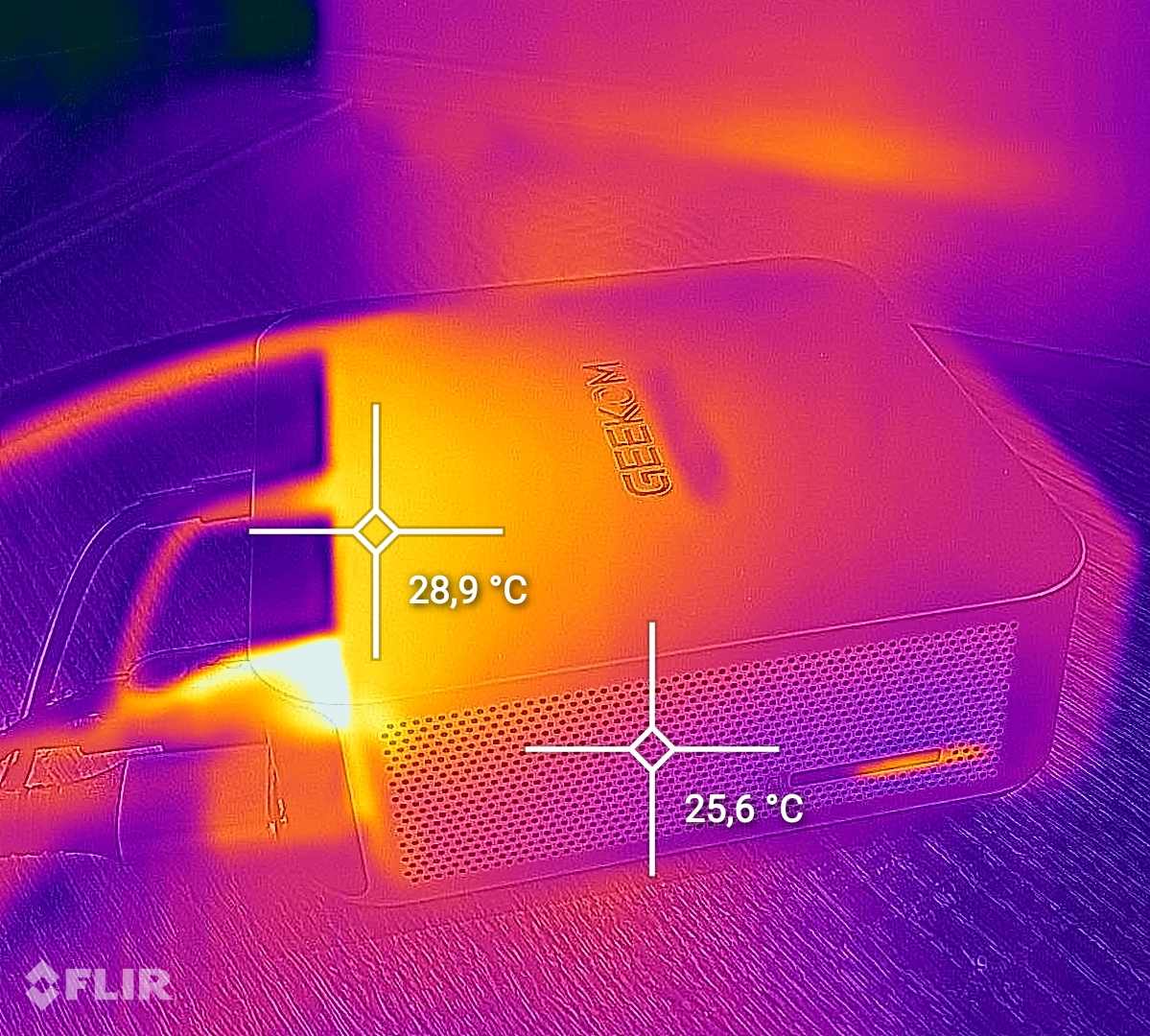
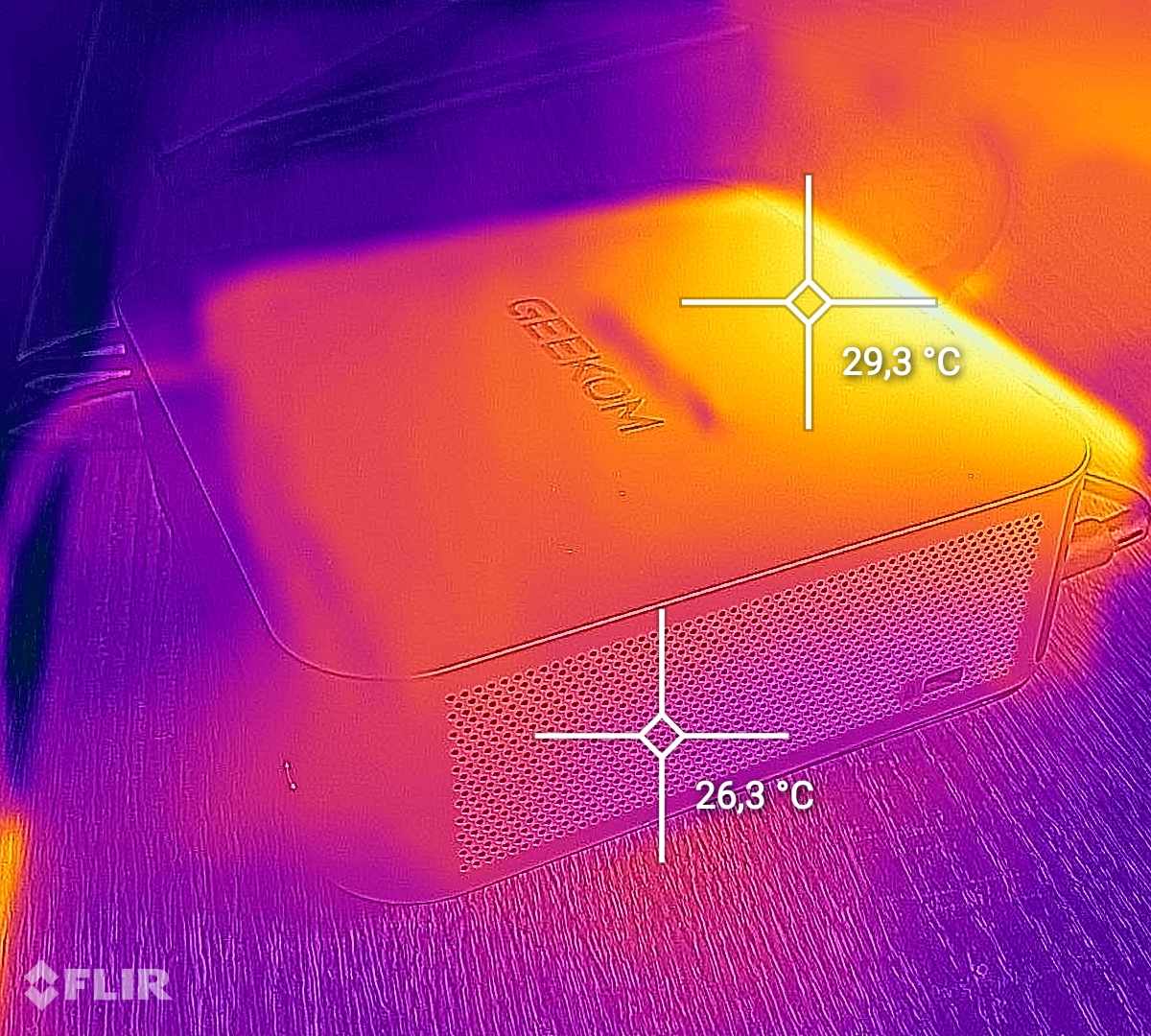
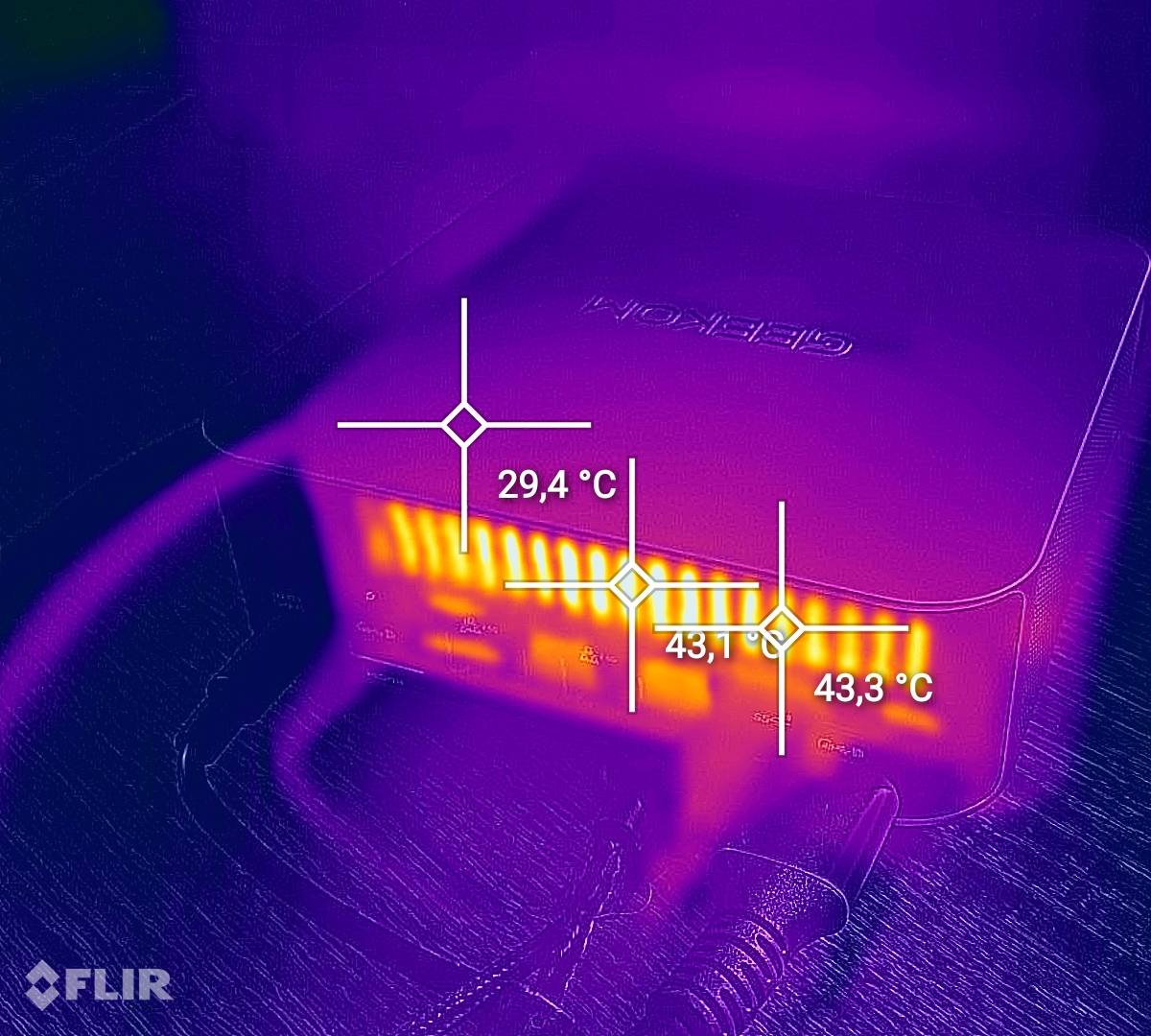
The top cover doesn’t exceed 35°C in temperature, with the highest reading around the vent at approximately 44°C. If you’re working on long, intensive tasks, the CPU may throttle slightly to maintain temperature control, but for most users, this won’t be a significant issue. Overall, the cooling solution strikes a good balance between performance and noise, making it suitable for both home and office environments.
Conclusion
The Geekom GT1 Mega stands at the pinnacle of mini PC innovation. It’s blistering fast for its size, thanks to Intel Core Ultra processors and Arc graphics. It boasts numerous modern connectivity options, including USB4, and ample 2 TB storage capacity. Furthermore, it’s plug-and-play for AI tasks and multitasking with Windows Copilot. You can’t forget that it’s energy-efficient and robust for an office, studio, or living room with a pre-installed Windows 11.
Priced at almost a grand for my spec, it’s not the cheapest, or smallest, but absolutely worth considering for those wanting flagship power in a tidy, tiny footprint. Striking words of caution, keep in mind the potential for overheating and noise when the device is pushed to its limit.
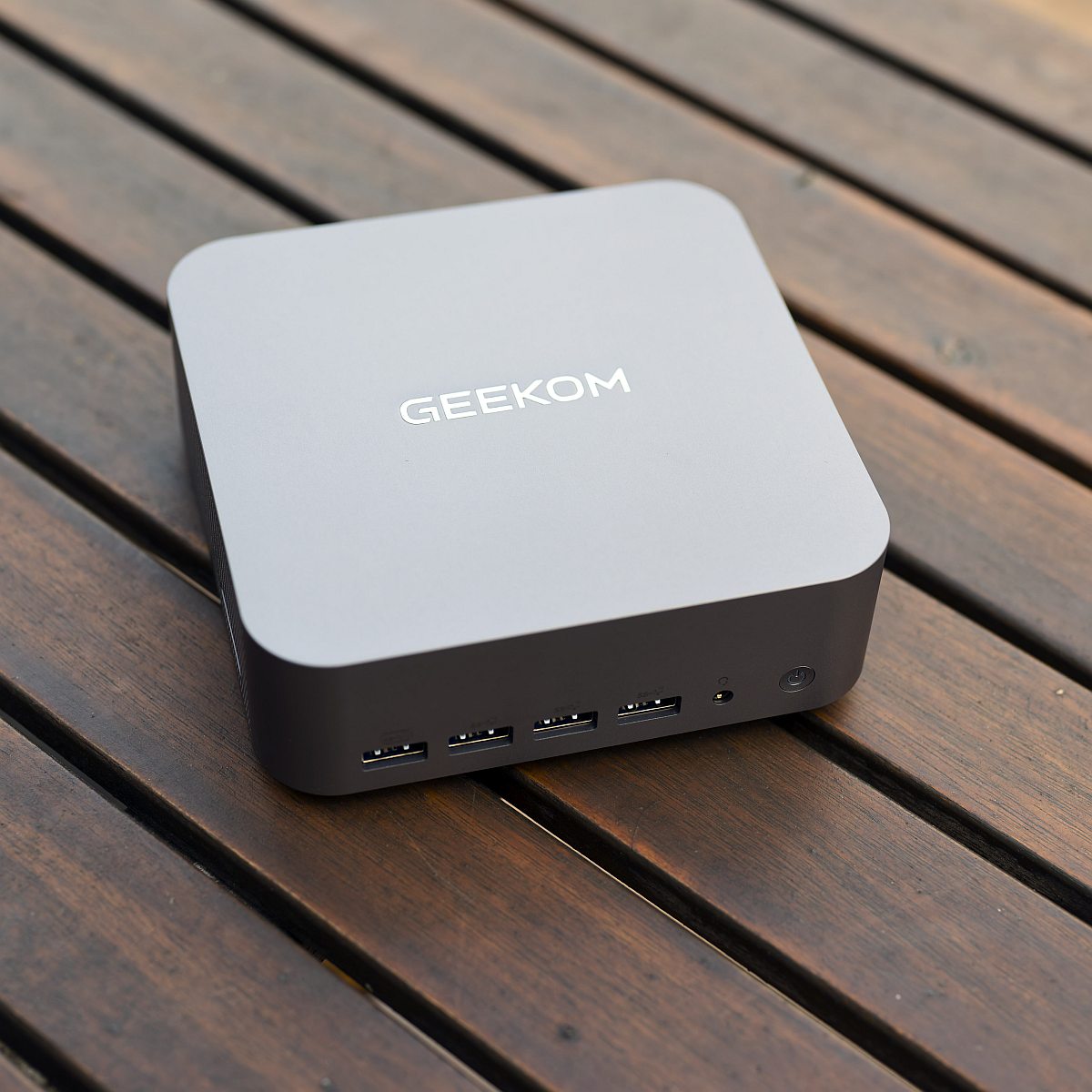
This little box of tricks is capable of delivering a more than decent gaming performance, although it’s essential to remember that it’s not a serious gaming rig. There’s no room for an internal power supply or USB-C charging, so you’ll need to have the bundled power brick on hand. Among the other drawbacks, there’s no USB Type-C port at the front of the device and a lack of official support for 4TB storage devices.
Yet for professionals, creatives, and tech-forward users wanting power, flexibility, and style in a compact form, the GT1 Mega is one of the class-leading choices that won’t disappoint. Monitor pricing for sale events; it’s an excellent investment when deals appear.


